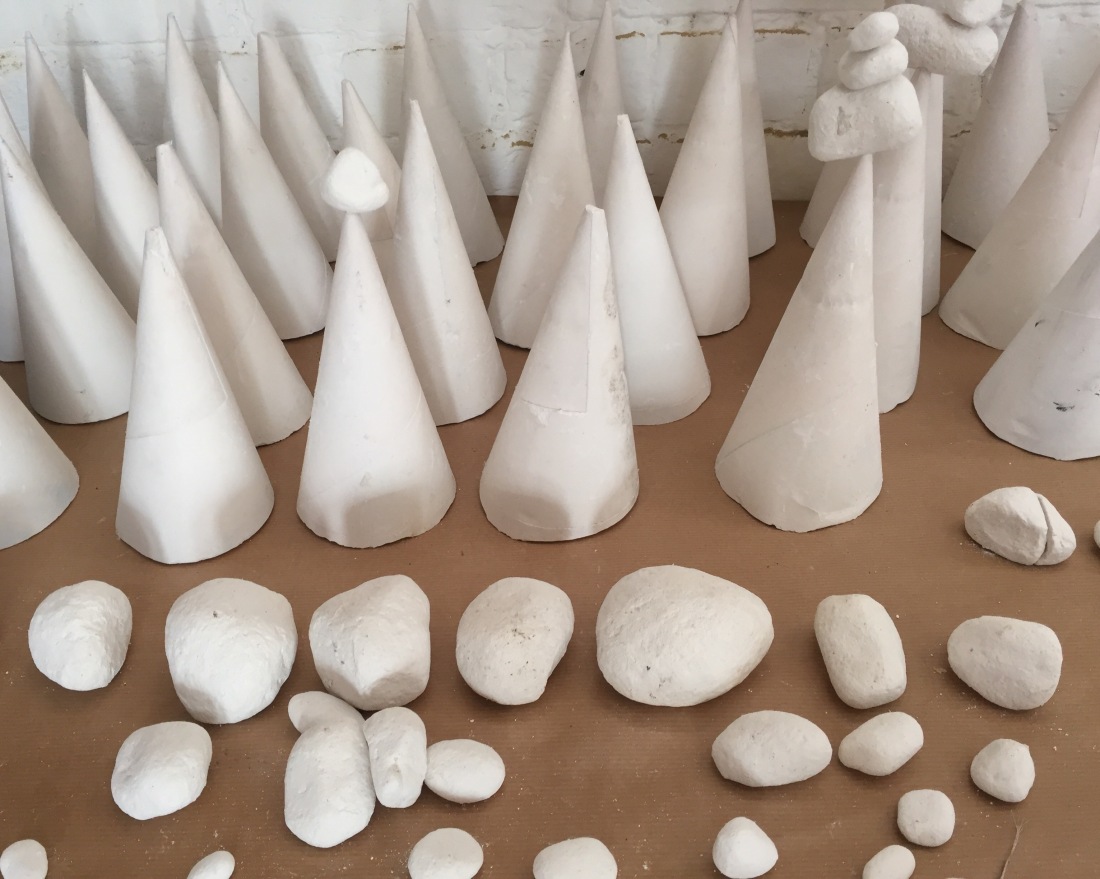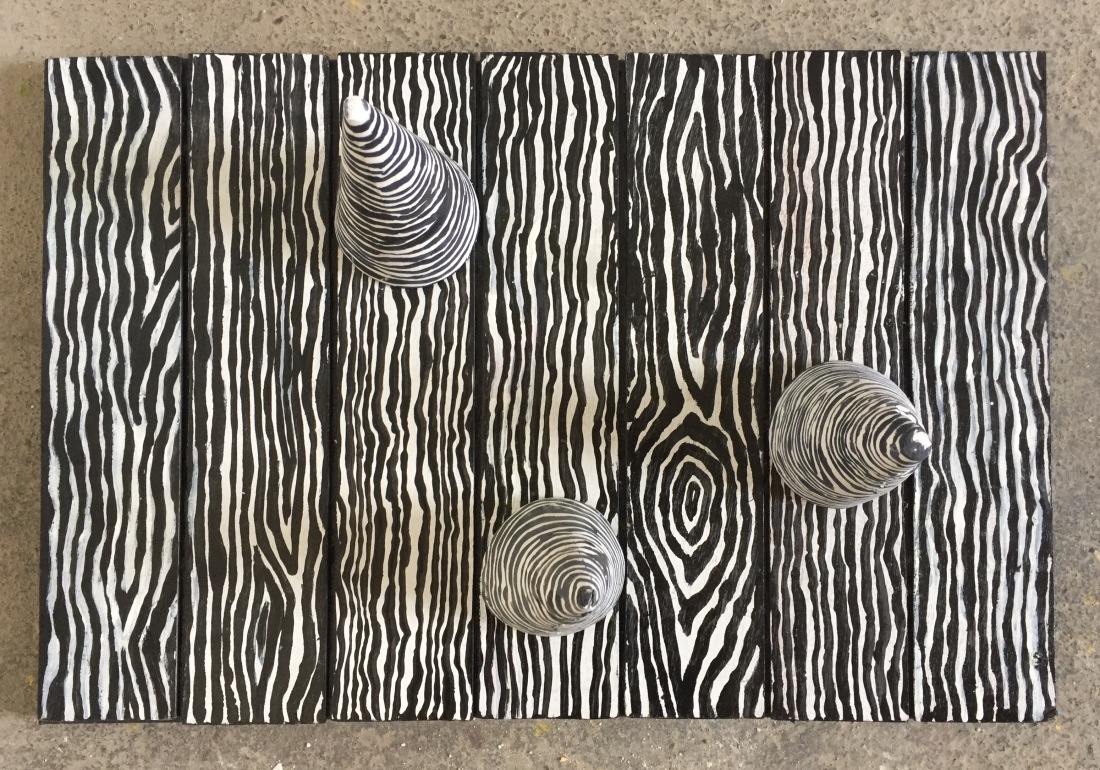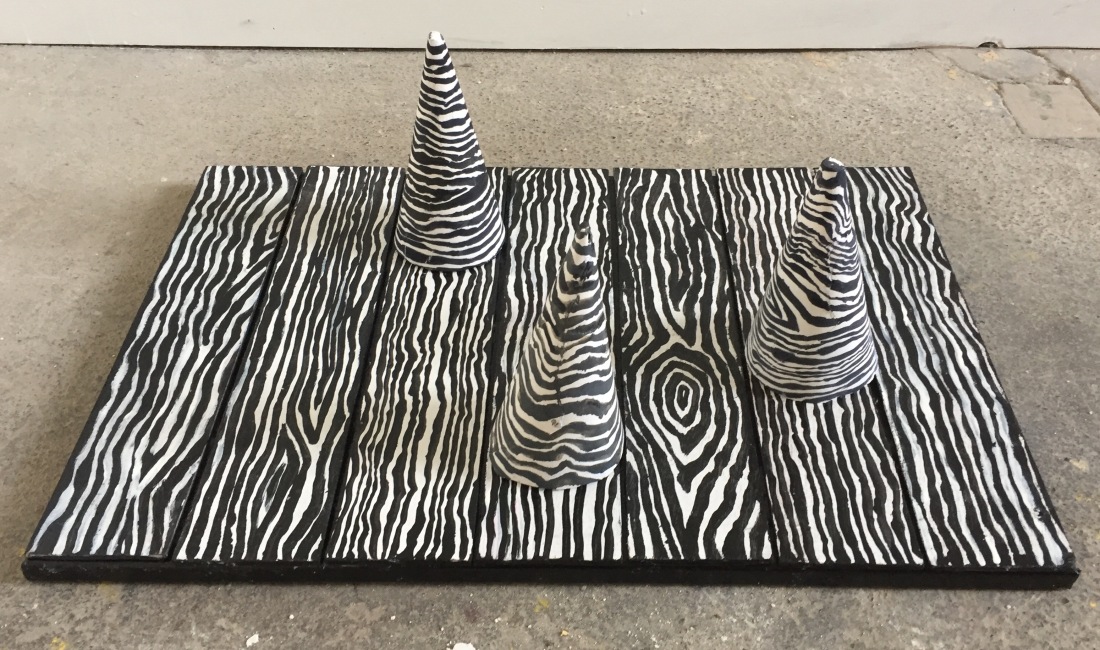PEGWELL RESEARCH
Please click link above to see a PDF about my work around Pegwell.
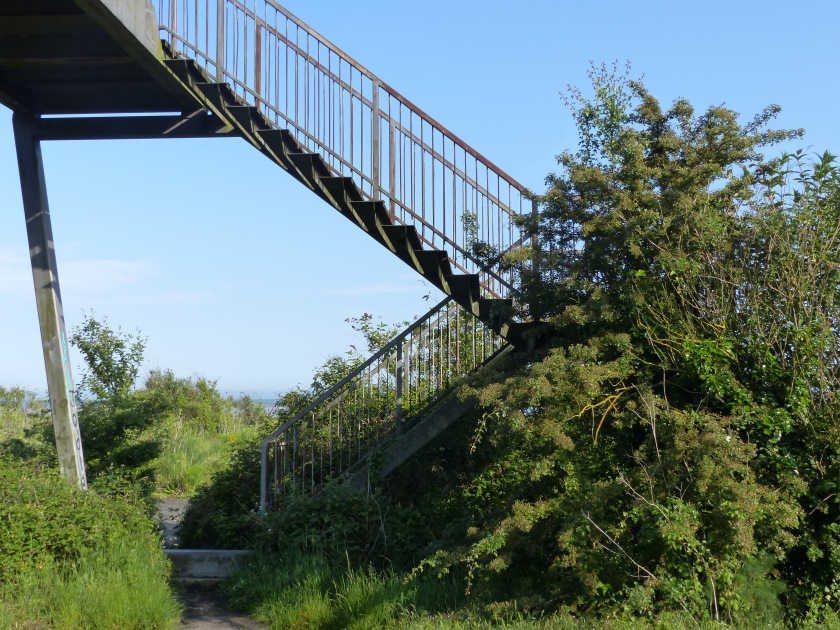
Edgeland
Plants submerge tarmac.
Creeping waves of moss, stone crop, ivy,
Buddleia, in a gathering crescendo.
Colonisation in the cracks, stitching seams of cast concrete
Red shale, like Samian ware, terracotta warm, scattered between the orchid army
Asphalt meets sea,
oyster reefs tentatively embedding at this union
White shells
On bitumen black
Fragrance of fennel and chamomile
Parakeets wheeling, vivid green,
Circling parking bays, the launch pad,
the bridge to nowhere.
Steps
cats eye sockets
markers, bollards, eroded posts.
Dog roses and old man’s beard abut car park conifers
The roundabout a jasmine oasis
Cliff face hanging gardens
Return of the wild
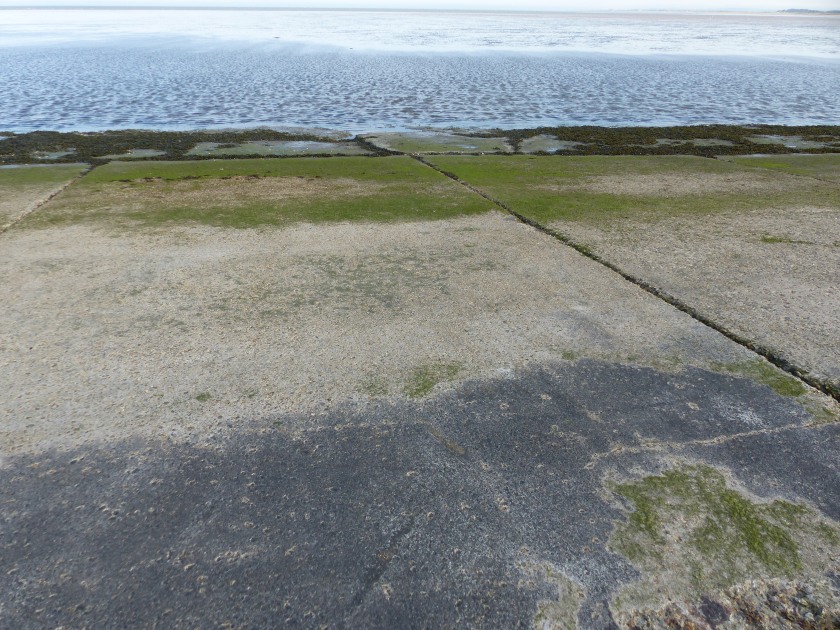
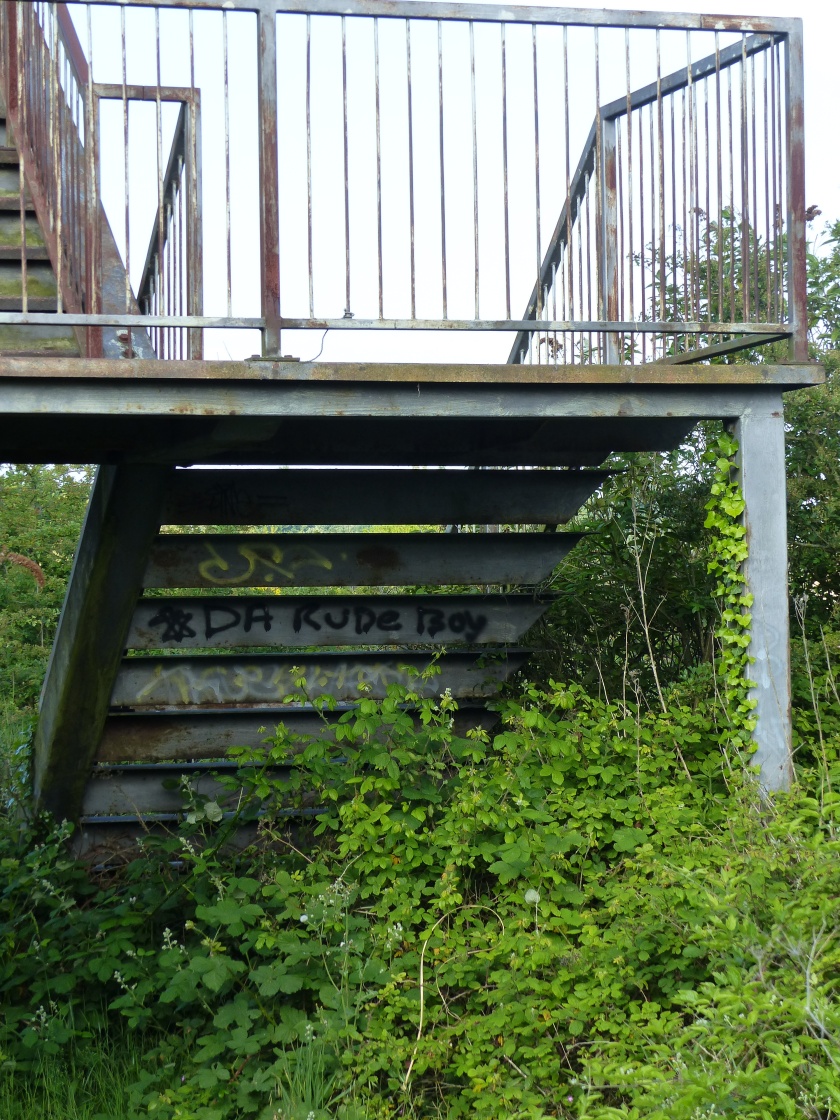
CURSUS CERVE/THE DEER’S COURSE : ST. MILDRED’S LYNCH
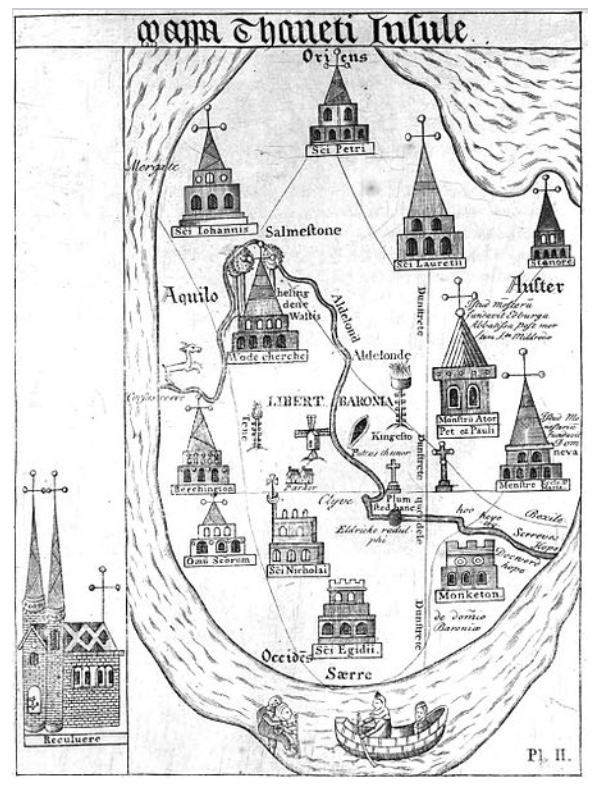
Medieval map of Thanet showing the Cursus Cerve (the course of the deer). When St. Domneva established Minster Abbey in the seventh century, the boundaries of its land were determined by how far her pet hind would run. The land was in lieu of wergild, blood money, offered to her by King Ecgberht of Kent as recompense for the murder of her brothers. The deer set out from Westgate and ran to Minster. This line later became known as St Mildred’s Lynch and was believed to be an ancient ridge, although it may have been created to divide the manors of Monkton and Minster.
And hio ða swa dyde þæt hio þæt wergeld geceas þurh Godes fultum on ðam iglande þe Teneð is nemmed: þæt is þonne hundeahtatig hida landes þe hio ðær æt þæm cyninge onfeong. And hit ða swa gelamp þa se cyning and hio Domne Eafe ærest þæt land geceas, and hi ofer þa ea comon, þa cwæð se cyning to hire hwylcne dæl þæs landes hio onfon wolde hyre broðrum to wergilde. Hio him andsworode and cwæð þæt hio his na maran ne gyrnde þonne hire hind utan ymbe yrnan wolde, þe hire ealne weg beforan arn ðonne hio on rade wæs. Cwæð þæt hire þæt getyðed wære þæt hio swa myceles his onfon sceolde swa seo hind hire gewisede. He ða se cyning hire geandsworode and cwæð þæt he þæt lustlice fægnian wolde. And hio ða hind swa dyde þæt hio him beforan hleapende wæs, and hi hyre æfter filigende wæron, oðþæt hi comon to ðære stowe þe is nu gecwedon Þunores Hlæwe. And he ða se Þunor to ðam cyninge aleat, and he him to cwæð, ‘Leof, hu lange wylt ðu hlystan þyssum dumban nytene, þe hit eal wyle þis land utan beyrnan? Wylt ðu hit eal ðære cwenon syllan?’ And ða sona æfter þyssum wordum se eorðe tohlad.
(Old English source, an eleventh-century text which is edited in M. J. Swanton, ‘A Fragmentary Life of St. Mildred and Other Kentish Royal Saints’, Archæologia Cantiana xci (1975), 15-27).
I am planning to walk a line which I think approximates to the Cursus Cerve- marked with the dotted line on the map below which splits Thanet in two.
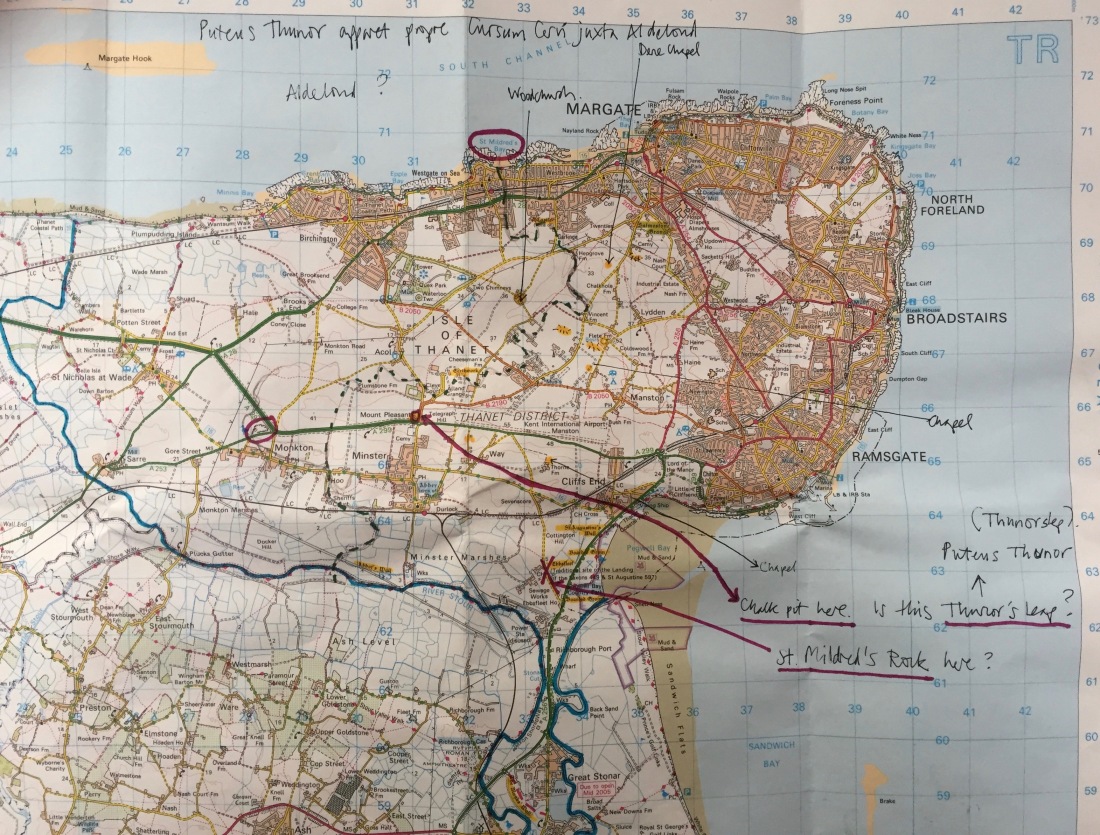
- St. Mildred’s Bay
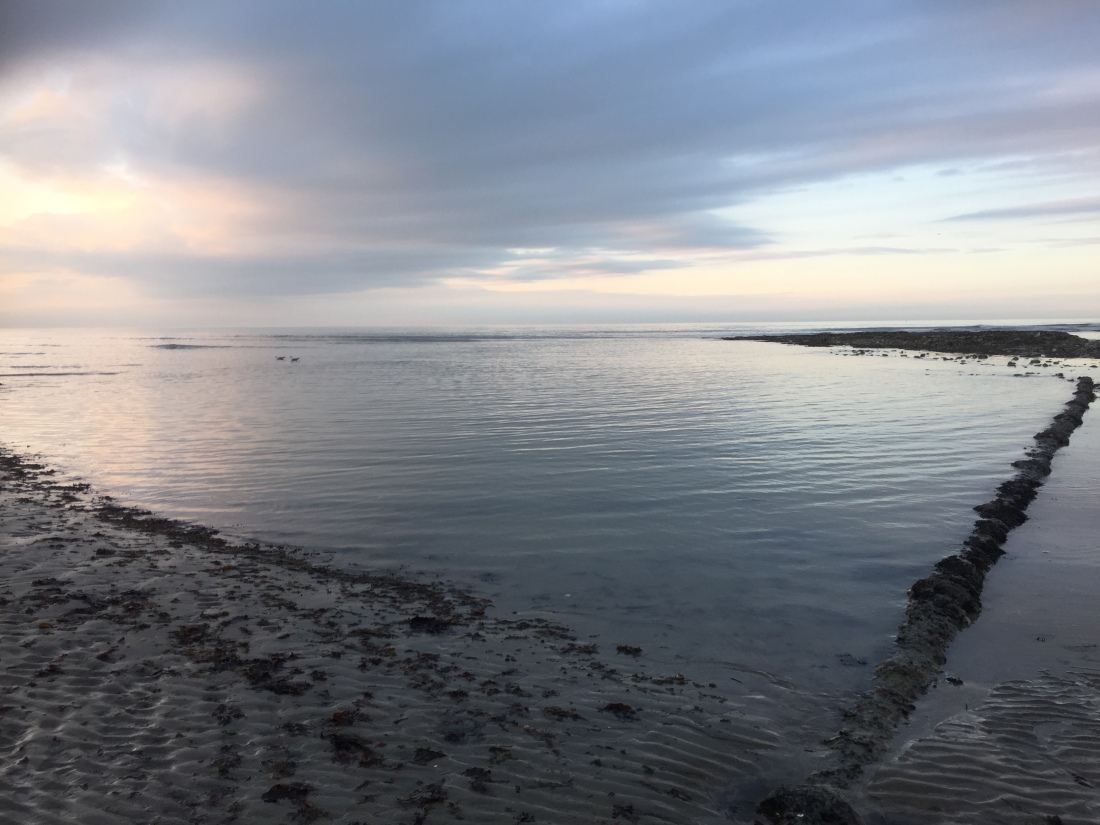
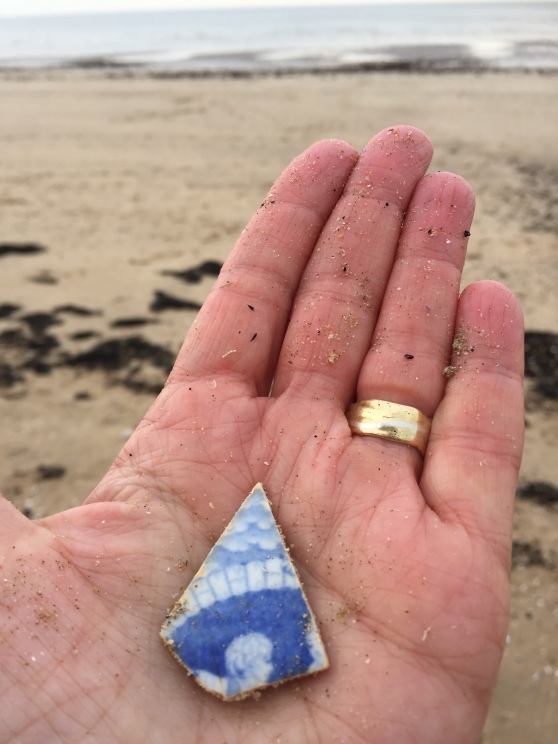
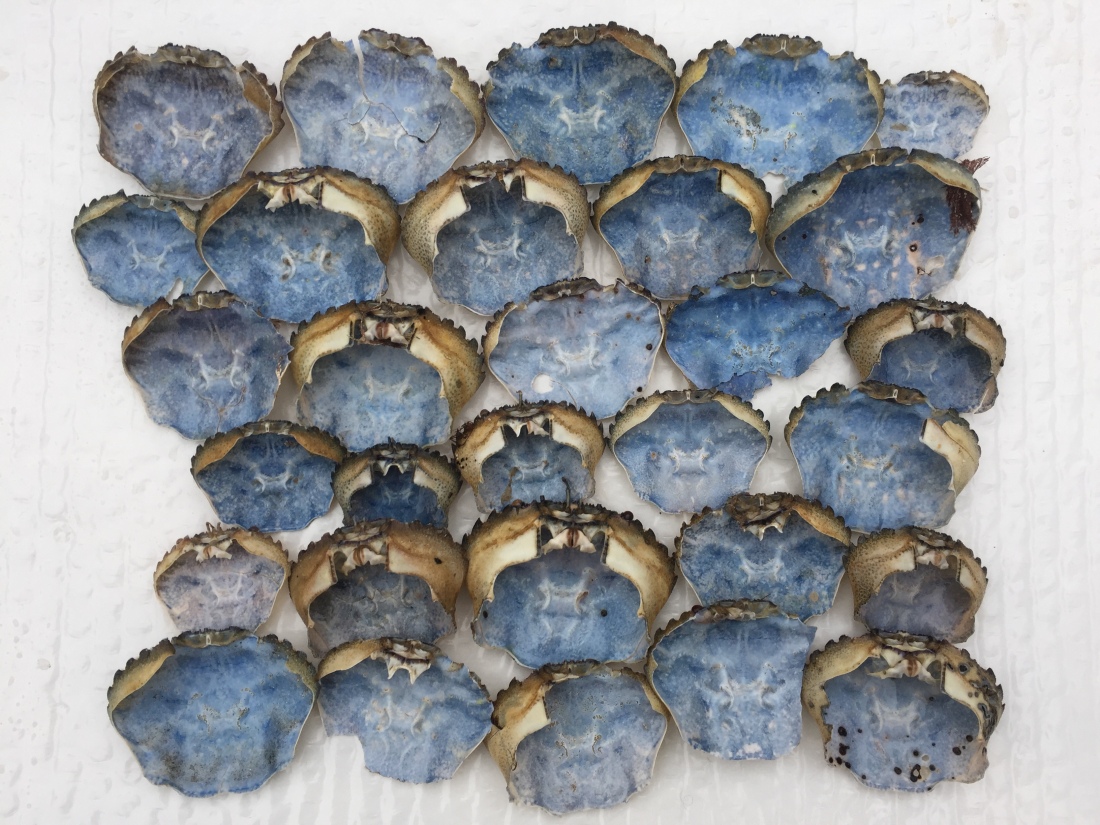
At St. Mildred’s Bay. Walking over the creamy coloured oyster reefs, the occasional shell open and glistening, mouth-like, the rocks like bones. Black winkles clustered on the white flint skin like freckles.
Where would a hind run? Ugly housing fills gaps where cliffs must have crumbled: no deer tracks here.
Amongst banks of seaweed are scattered empty crab shells, mottled blues as if indigo dipped. Celestial blue. The relics of past saintliness .
I find a blue and white shard, a Chinese/ willow pattern design, the cobalt colour of the crabs. Two people depicted on it, I think of Domneva asking King Ecgberht for her pet hind’s run to determine the boundary of her land. Waves descend behind the earnest faces, negotiating territory and redemption.
2. Raising the hind
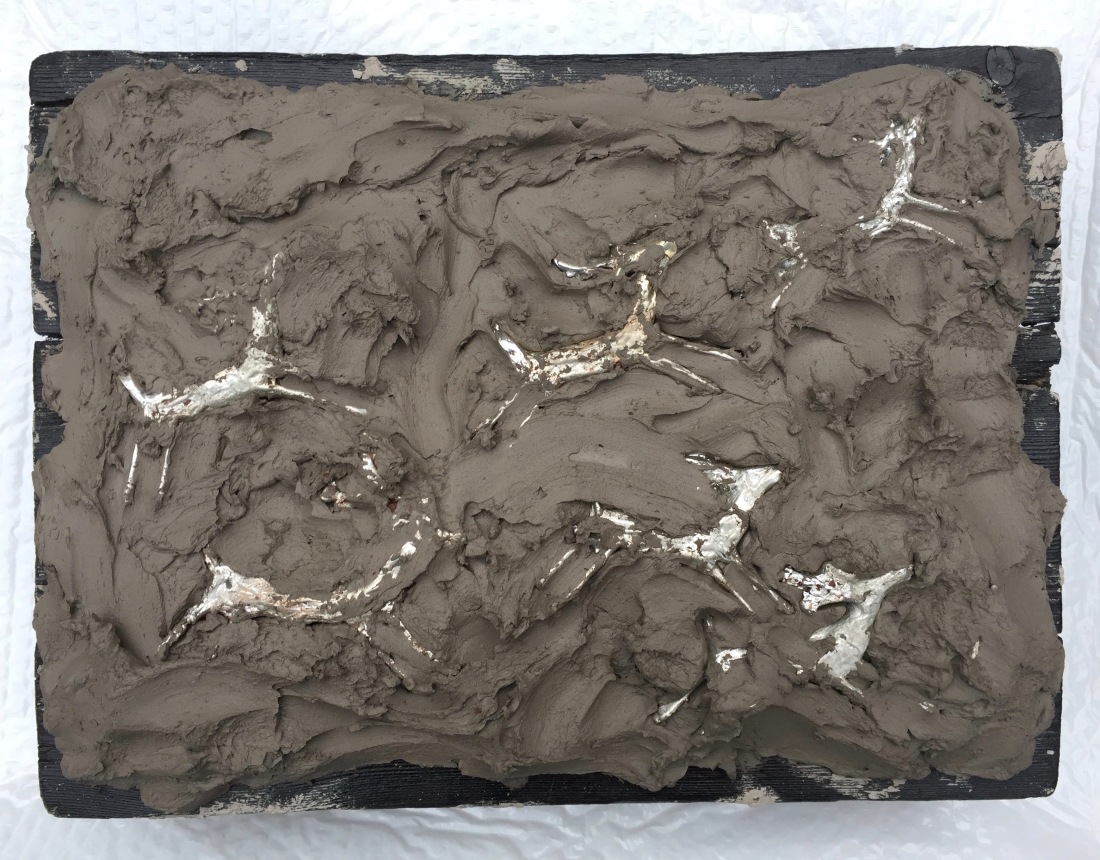
Excavation altar (bird’s eye view): mud and exposed pewter deer “relics”.
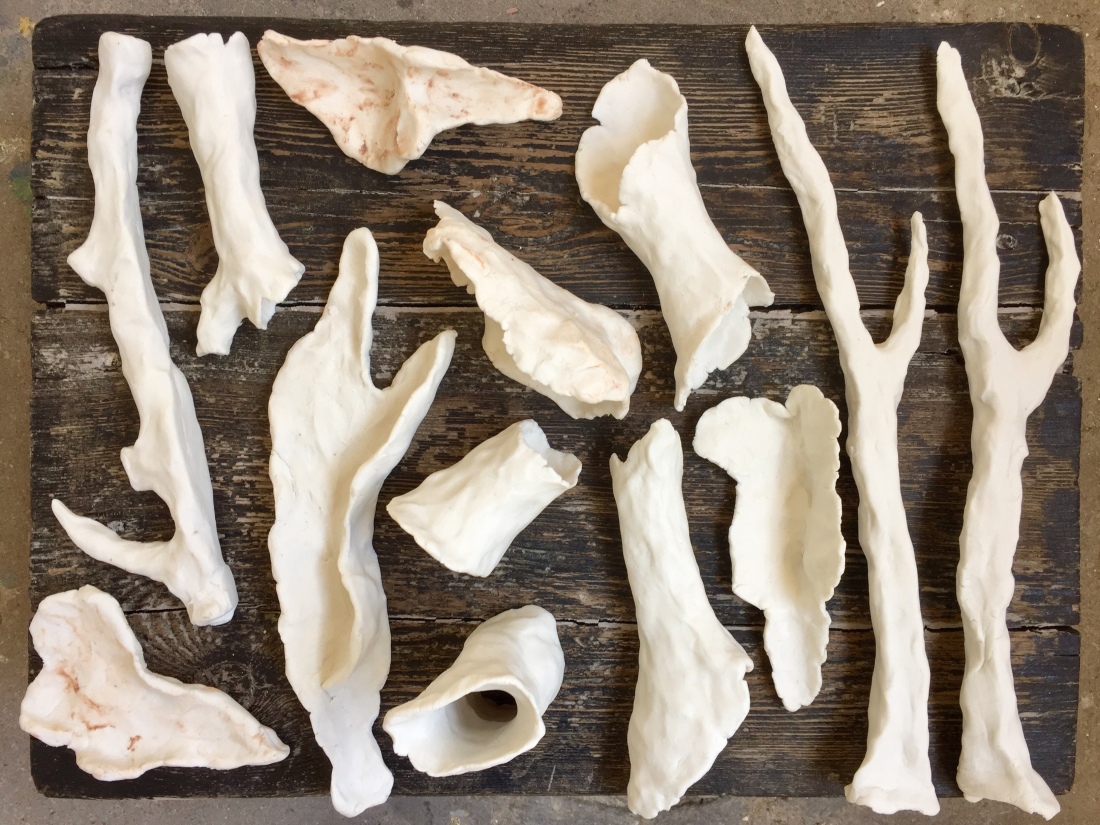 Deer bones and antler fragments (porcelain).
Deer bones and antler fragments (porcelain).
Postscript.
I took the crab shells home, greedy for their colour. I left them for a day and found they had changed-a transformation to purity and whiteness. When adding salt water to them they regained their blue shading, though without the previous intensity. I intend to use these as votives for the walk, a pilgrim’s offerings to Domneva and Mildred.
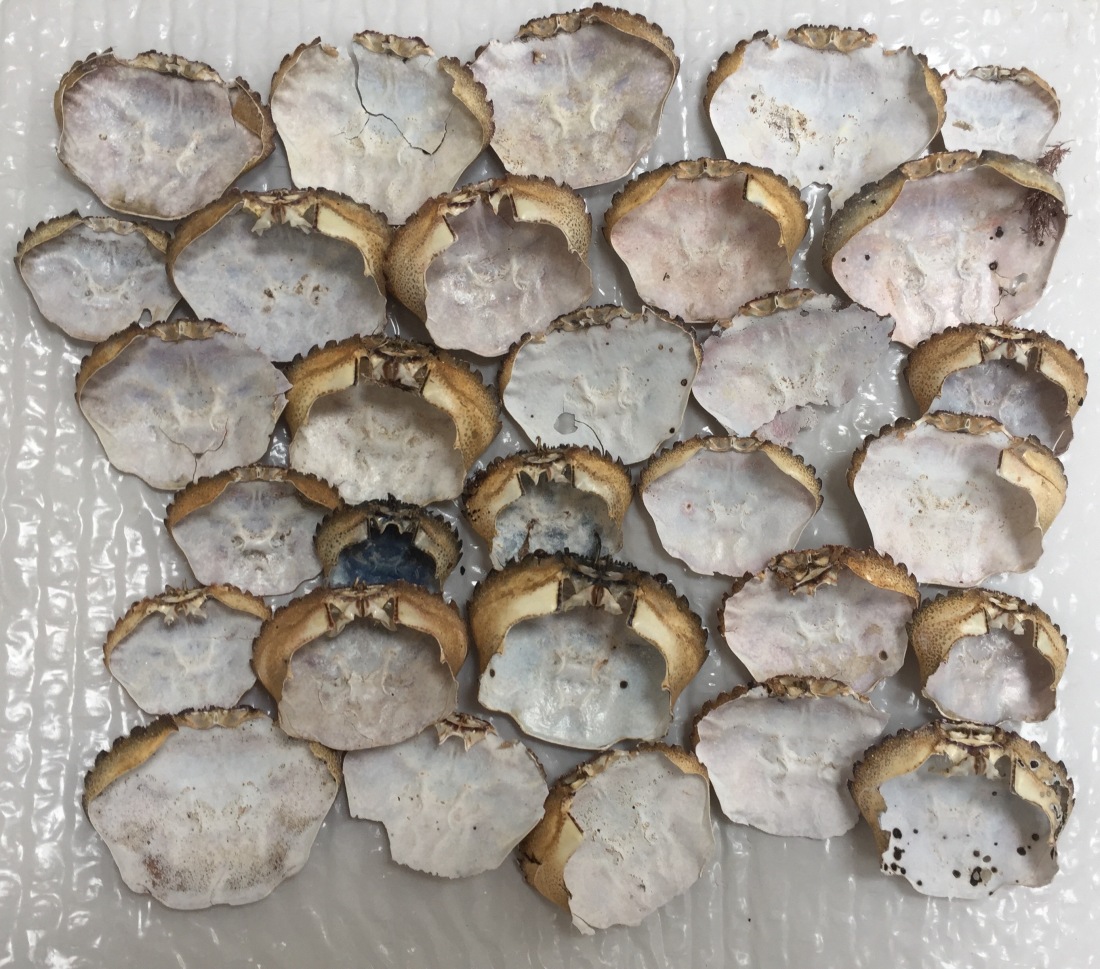
QUEST DIARY ENTRIES
The Quest.
Fractured sleep, battered and tossed in the storm of dreams, at sea. Dreamt I was stumbling about on a sandbank, looking for something or someone who eluded me. I woke up in a panic, like a landed fish , agitated, my head full of the dream images, struggling to make sense. Lying in the dark, I heard a voice distant and deep inside me, speaking with quiet authority, stating the rules of the quest. I listened, in a trance, strangely calmed. As the voice became more distant I reached for my pen and wrote down as much as I could remember. I think there was far more, I even felt that the voice was still intoning somewhere out of my hearing.
This is the challenge, accept it if you desire.
What you seek is to be found within the tides, on the sands of Pegwell, of Sandwich, and of Goodwin. Use only what can be found in these sands for your quest.
Fetch Goodwin water in a sieve. Convey it in a wagon with no wheels, in a boat with no keel. Contain the water in vessels of Pegwell mud, dug with no spade. Paint the sands with the ink of the sea. To tie the winds, bind Sandwich stones in knots, and make a rope of Goodwin sand. Let three tides pass over it.
Then you will see what is hidden. You will gain mastery of the tides. You will acquire charms to enchant or to drive away as you will. Your way will be clear.
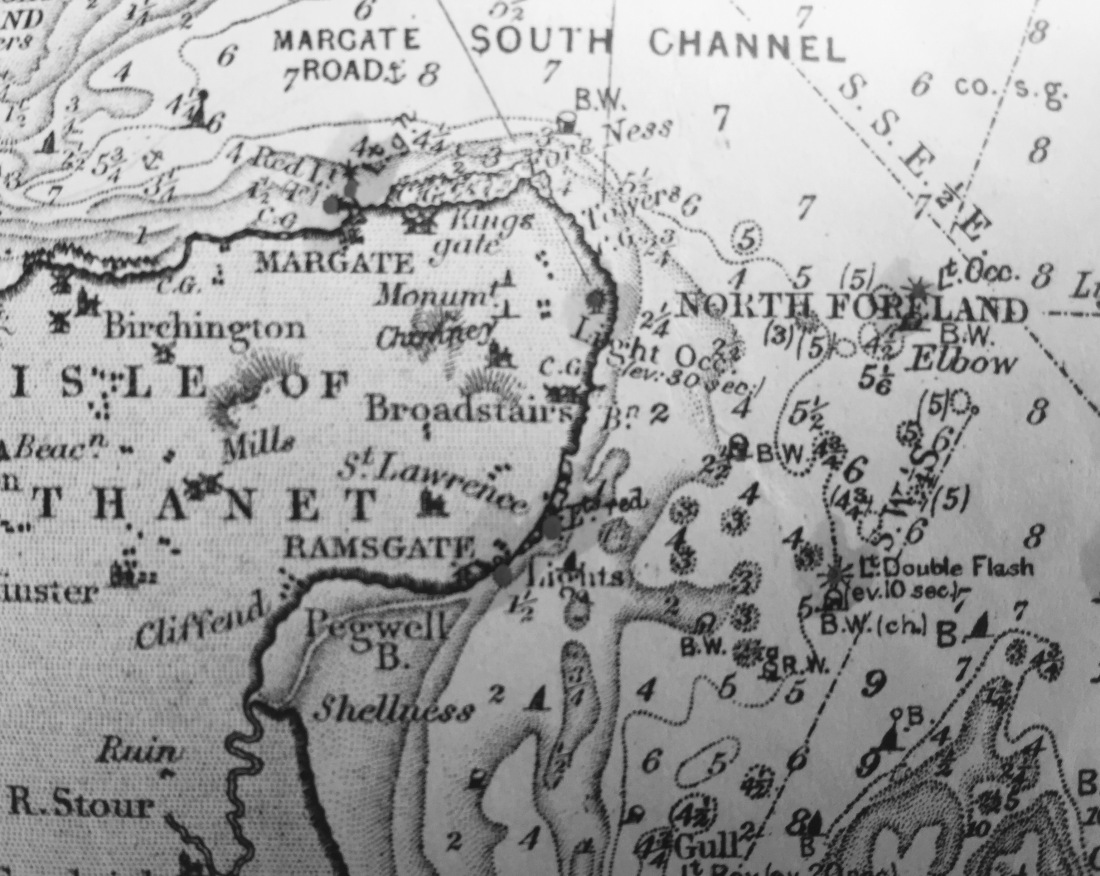
Pegwell Bay 1.
Scouring the bottom of the cliffs for Darwin’s fossils. The dazzling white of the chalk around me is echoed by the egrets moving busily through the samphire marshes, their eerie cries breaking into my reverie: the purity of this palette disrupted by the muddy debris of seaweed tangled rubbish and the stench it exudes. Sanitary plastics and rusting metal intermingled with weathered brick and old pottery shards. At the abandoned hover port, by the forlorn staircase and bridge to nowhere, there is a wilderness of what was once standard municipal planting: conifers, roses, buddleia, camomile and fennel intermingle incongruously in a wild cacophony. Overhead the parakeets are screeching and complete the dystopian panorama before me.
Pegwell Bay 2.
We walk across the bay to the sea. On our horizon we can see a line of cable and men working. The mud is dense and sucks at our feet: we do not have boots on, so now we sport muddy leggings and saturated shoes. The men still seem way off but we keep trudging warily through the mud towards a chair positioned close to a section of cable. Empty. Canute has been successful in turning back the tide here: in the opalescent light the sea seems as though it is a mirage and is far, far away.
Finally, a workman comes over, curious as to why we have trailed out this distance in the mud. He is not working on the archaeological excavation we had hoped we would find here. It is the last stage in the laying of a power line being connected to England from Belgium, a new invader in the succession of those who have landed here. We thank the workman, and turn and head back to the beach.
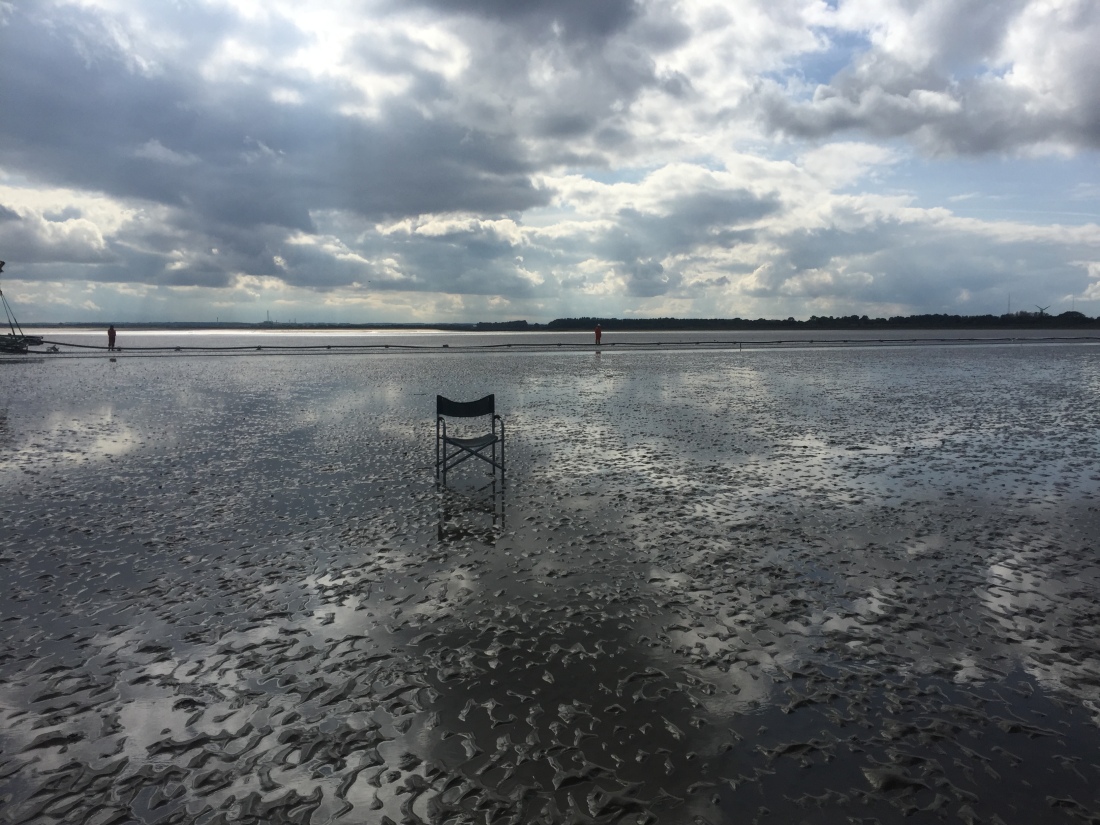
Pegwell Bay 3.
I had parked up by the Viking Ship and a couple walking their dog helped me carry the sledge down the steps onto the Hover Port tarmac. I suspect they soon regretted this act of generosity, as it was so awkward manhandling it down the narrow steps, and it seemed to get heavier by the second. The Viking ship and the ghosts of hovercraft watch over my struggles with my sledge, another obsolete mode of travel. I dragged it onto the sands and it almost seemed to glide on their firm, dry surface: but as I wade out into the mudflats the sledge starts to sinks and stick, as do my feet. When I look back at my footprints they have an odd optical effect in the sunlight and look as though they are turned out of, rather than into, the mud.
I decide that this is as close as I want to go to discovering the “treacherous bogs” in the guide to Pegwell Bay. I take the tools I made at Sandwich Bay out of my box and scoop up small quantities of the mud. It is mid to dark brown for a few centimetres, then below becomes thick, black and treacly. In places it seems like a rich tarmac and I hope this is what it is rather than anything less pleasant, which its strong smell suggests it might be. I place it in my box. I decide that was enough as the challenge didn’t state how much mud I needed. I sit on the sledge for a few minutes, catching my breath and watching an oyster catcher, marvelling at the length of its beak. then I stir myself to begin my slow way back across the flats.
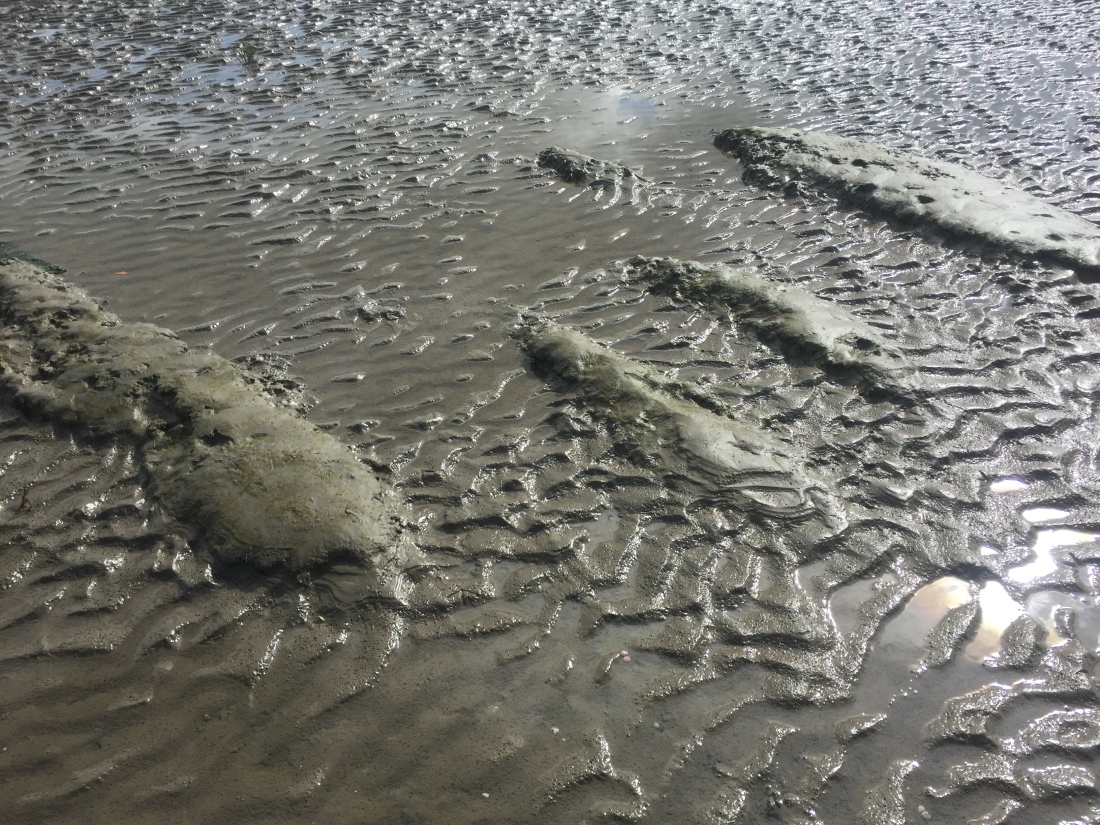
Goodwin Sands 1.
On the Lady Grace. We circle the Terschelling so that Jason the cameraman can fly his drone and get better documentation than he did on the approach. The boat sways gently, at ease with itself, the captain joking with the archaeologists’ two boys, unperturbed by our location above the Ship Swallowers. Jason is finished, Caroline catches the drone and it is packed away. We move off. The waves hitting the Sands seem to glitter more than the sea elsewhere, there is a silver quality to the water, punctuated by dark dots denoting the heads of seals bobbing up and ducking under the water. Gannets fly alongside us and the water surf flies up exhilaratingly as the captain accelerates away from the Goodwins. We strain to see the last suggestion of sandbanks and return to the cabin where the archaeologist shows us the plastic bag she is holding; it contains silver coins retrieved from the Rooswijk.
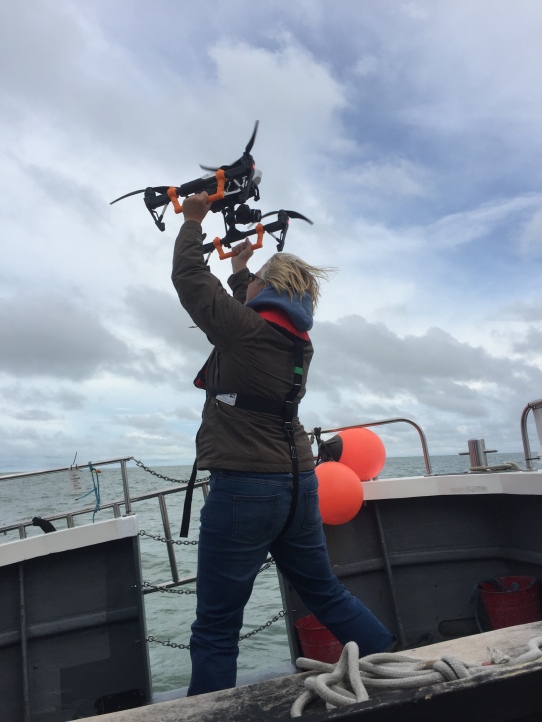
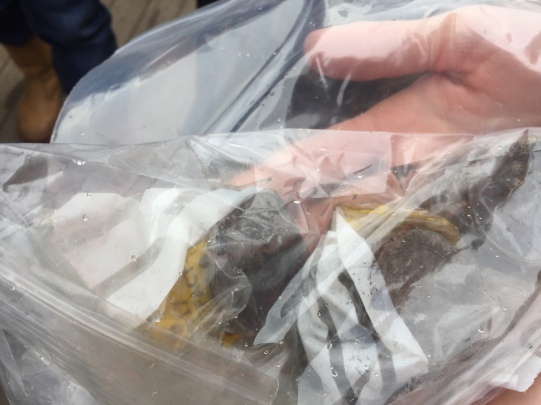
Goodwin Sands 2.
Back on the Lady Grace. Matt, the captain, looks doubtfully at the sledge on the quayside. I assure him we can lift it on and off without jeopardising his boat. We heave it aboard. The boat rocks and Matt grimaces. I inwardly curse the sledge’s weight and unwieldiness.
The sea is calm and we make good progress. I sit in the cabin with Matt, and watch the map readings on his screen. The Goodwins appear, and I feel excited and apprehensive. I am amazed at the extent of the sands, and their emptiness. Matt steers into the shallows and drops anchor. He tells me I have an hour and a half and I clamber out of the boat, jumping unsteadily into the water. Boots submerged, but the sand is firm beneath my feet.
Matt pushes the sledge over the boat towards me and I pull it awkwardly down onto the sand. He then passes me my boxes and basket, and I pile them onto the sledge and haul it away, self-conscious in his gaze, aware that I must look ridiculous.
The adrenalin of having arrived at my destination kicks in. An odd elation. The sands stretch out before me, sand lapped all around by sea. And it is seal land: the domain of those who can exist in both elements. But I cannot be distracted by the seals today.
The sledge is heavy and cumbersome: but my determination to reach the far tip of the North Brake, the closest point of the Goodwins to Pegwell, energises me, and the sands are enchanting. There is a watery sheen in areas, residual tide, which reflects the sky so I am walking in the sea, in the sky….shifting spaces. Submersion, emersion. I pull with renewed vigour and after 15 minutes arrive at what I believe to be the west end of the Brake.
I pull out my sheet from a box. I will draw the sands. I pour cuttlefish ink on the sheet, and blot the sands with the sheet. Ghostly impressions appear, marking the rhythms caused by tide lines. I take my tools and excavate sand, scooping it frantically in the small quantities my ill formed implements allow. The sand seems finer than usual, softer and devoid of shell fragments and stones.
Finally I scoop sea water awkwardly into my tiny clay vessels, nestling in the lumpen basket I found at Sandwich Bay. I realise it is easier to wade into the sea slightly to fill them but as I start doing this a tremor of fear suddenly runs through me. I think of Arthur Durham Divine’s German sabboteur, left marooned on the Goodwins watching the boat disappear, the boat he had commandeered to sail him to Belgium. I check my watch. I am in good time, but I now urgently want to be back on the Lady Grace.
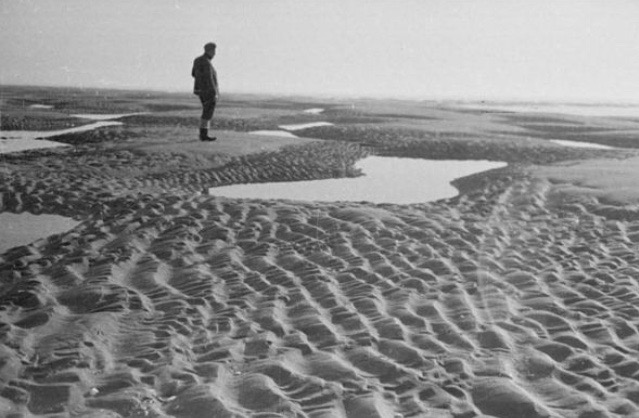
Sandwich Bay 1
On my way to the beach, walking down the track past New Downs Farm. The last farm before the Bay. On my phone I have a copy of the photo of my great, great grandfather, James Smith, on horseback, herding a flock of sheep, in front of the farmhouse. The building is almost unchanged and even now there is a small flock of sheep in the adjacent field.
James Smith farmed here in the early part of the twentieth century, and he was a renowned horse rider. Family history holds that he used to gallop across the bay each day on the huge horse he is astride in the photo. It is said that he used to ride the beast into the sea and that it would swim: if the current was favourable they would go in the sea as far as the river mouth, a considerable distance. James Smith apparently could not swim himself, but had such faith in his horse ‘s abilities he would entrust himself to the sea in this way. My grandmother said that the horses at New Downs were of Lomean stock, and given the chance, would swim back there.
Lomea. The third island, mapped by the Romans, a supposedly fertile island until it was consumed by the sea when Earl Godwin failed to pay for sea defences in the eleventh century. References to this submerged island continued through the centuries, re-ignited by Charles Lyell’s excavation of the Goodwins in 1817 when he found London clay on a layer of chalk, convinced this was evidence of a former land.
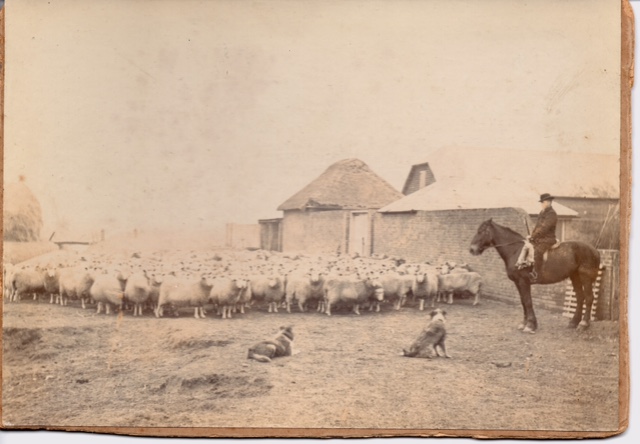
Sandwich Bay 2
Thinking about other family relationships with this stretch of the coast. Samuel Pearce, my grandmother’s grandfather, a Dover fisherman, was in one of the boats accompanying Captain Matthew Webb’s swim across the Channel, holding a lamp to help guide the swimmer’s way. The route went north from Dover towards the south Goodwins before veering across to France.
Or Fred, my father’s grandfather, a milk lad at Chilton, the farm on the cliffs above Pegwell, lodging in a room looking out to sea with a view of the Goodwins and the Bay.
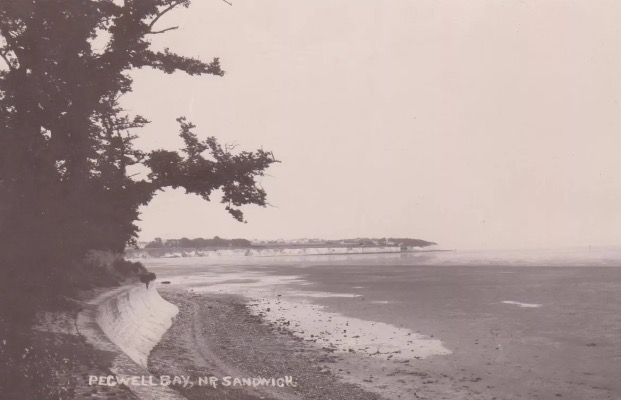
Sandwich Bay 3
Tool making. I find odd pieces of cloth and weathered leather shoe soles, but they don’t inspire me. They are not the barnacle encrusted oddities or fractured plastics I had hoped for. A triangular flint catches my eye- a prehistoric axe? It is lying touching a piece of sea smoothed wood. An arrow, pointing at the sea, pointing at possibilities. I pick the pieces up and walk in the direction it marked.
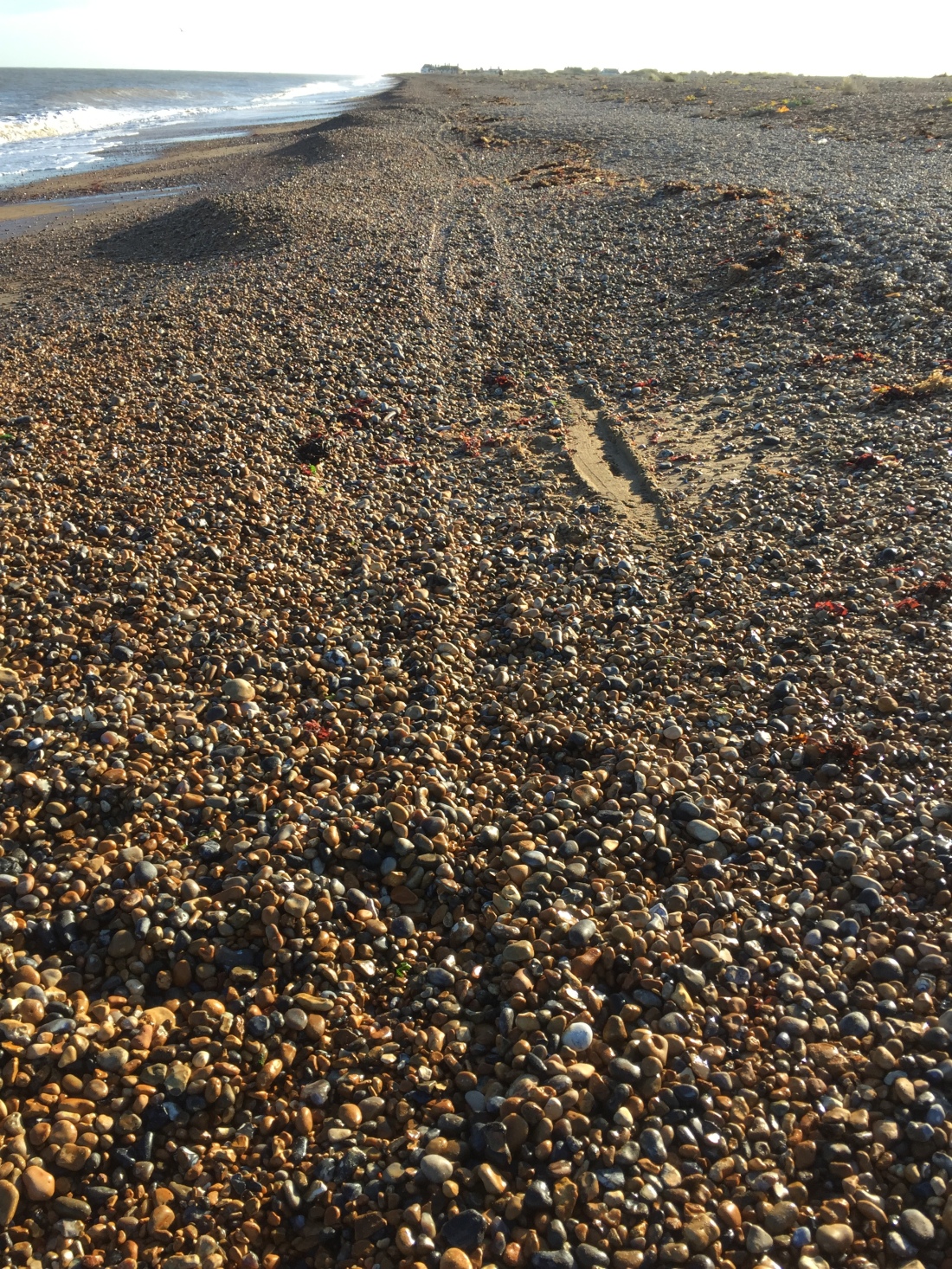
Sandwich Bay 4
The sledge glides easily over the pebbles and shingle. I had expected this to be hard, but the sledge seems made for this terrain. The tide isn’t very far out and the only sand showing is wet and cloying: it is almost impossible to drag the sledge on the saturated surface. I will stay on the shingle until I am nearer Shell Ness.
It is a gloriously bright day but the sea is rough and the waves sometimes shoot up to the shingle, moving around the sledge so that it is becoming a raft, weakly tied to the land by me.
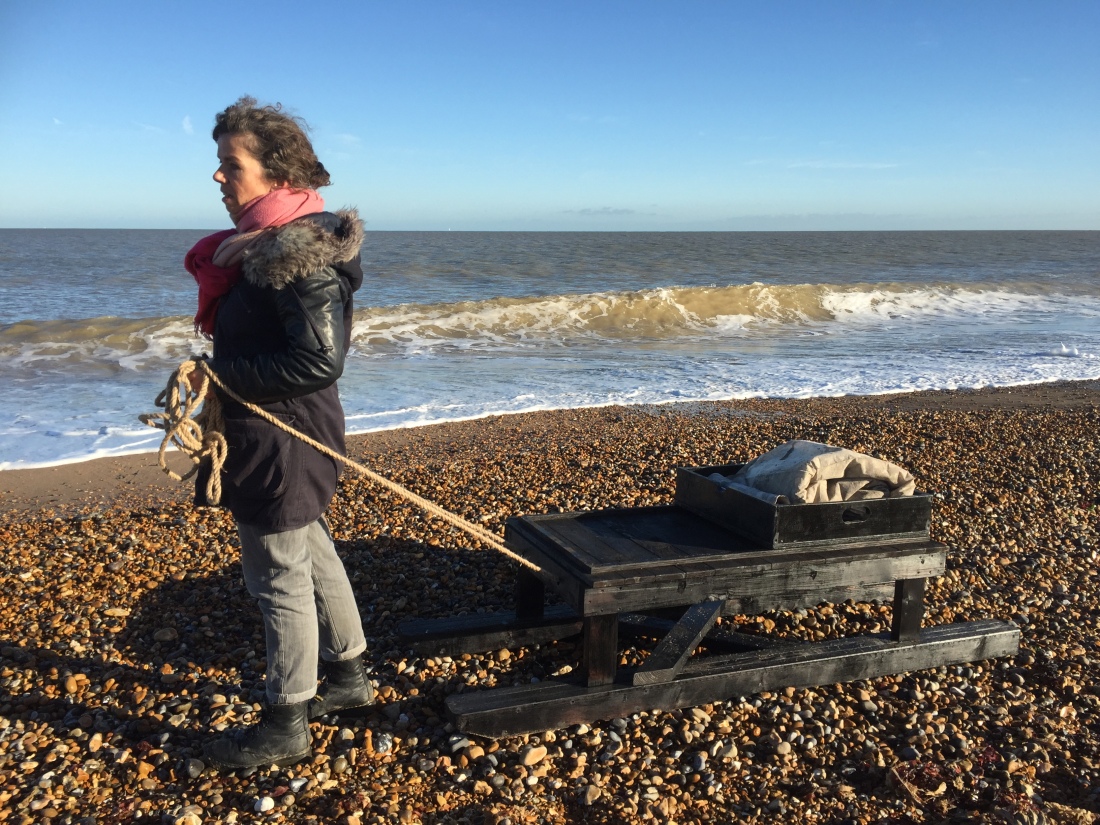
Sandwich Bay 5
Dusk. It is cold now, the sun has gone and I feel chilled. I resume dragging the sledge. Now that I have filled a box with sand and chalk stones it is heavier than ever. I crunch wearily over the bank of shells, lugging the sledge ever more slowly, until I reach the smoother sand. The distance back to the car looks interminable but I feel triumphant with my stash of materials. I have completed a major part of the Quest.
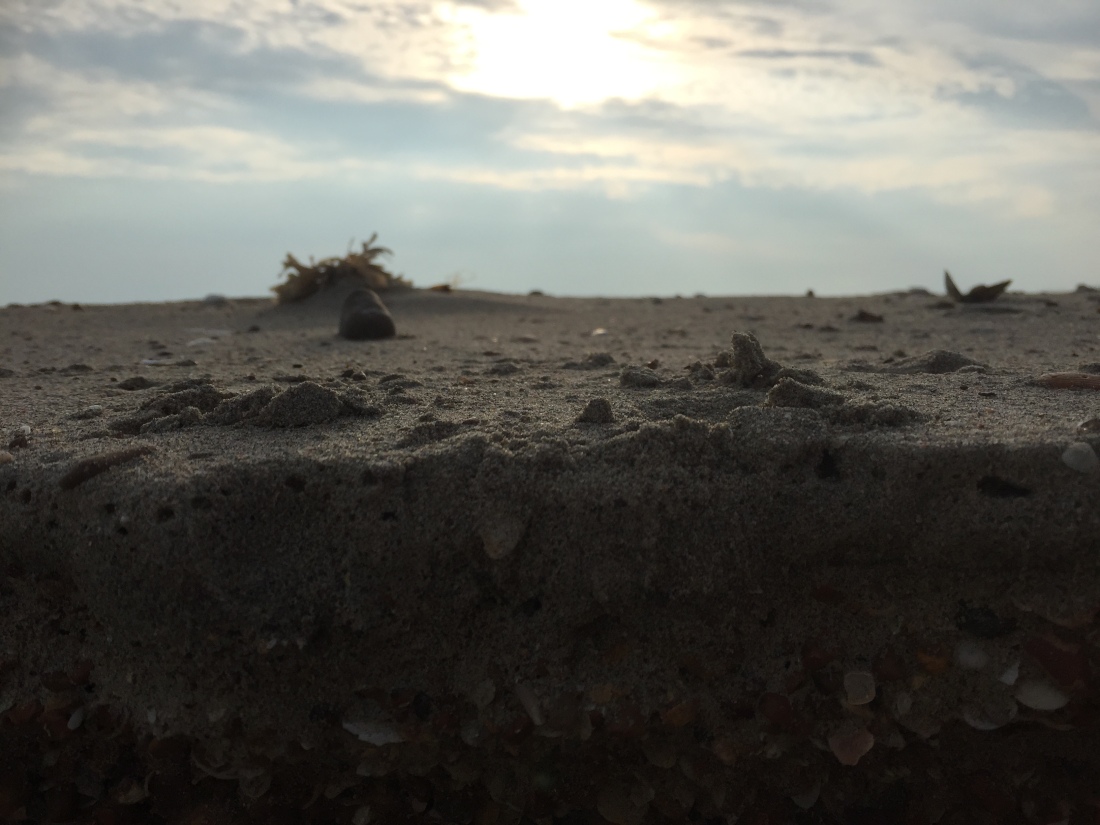
‘and the earth that is brought to thence will kill them’
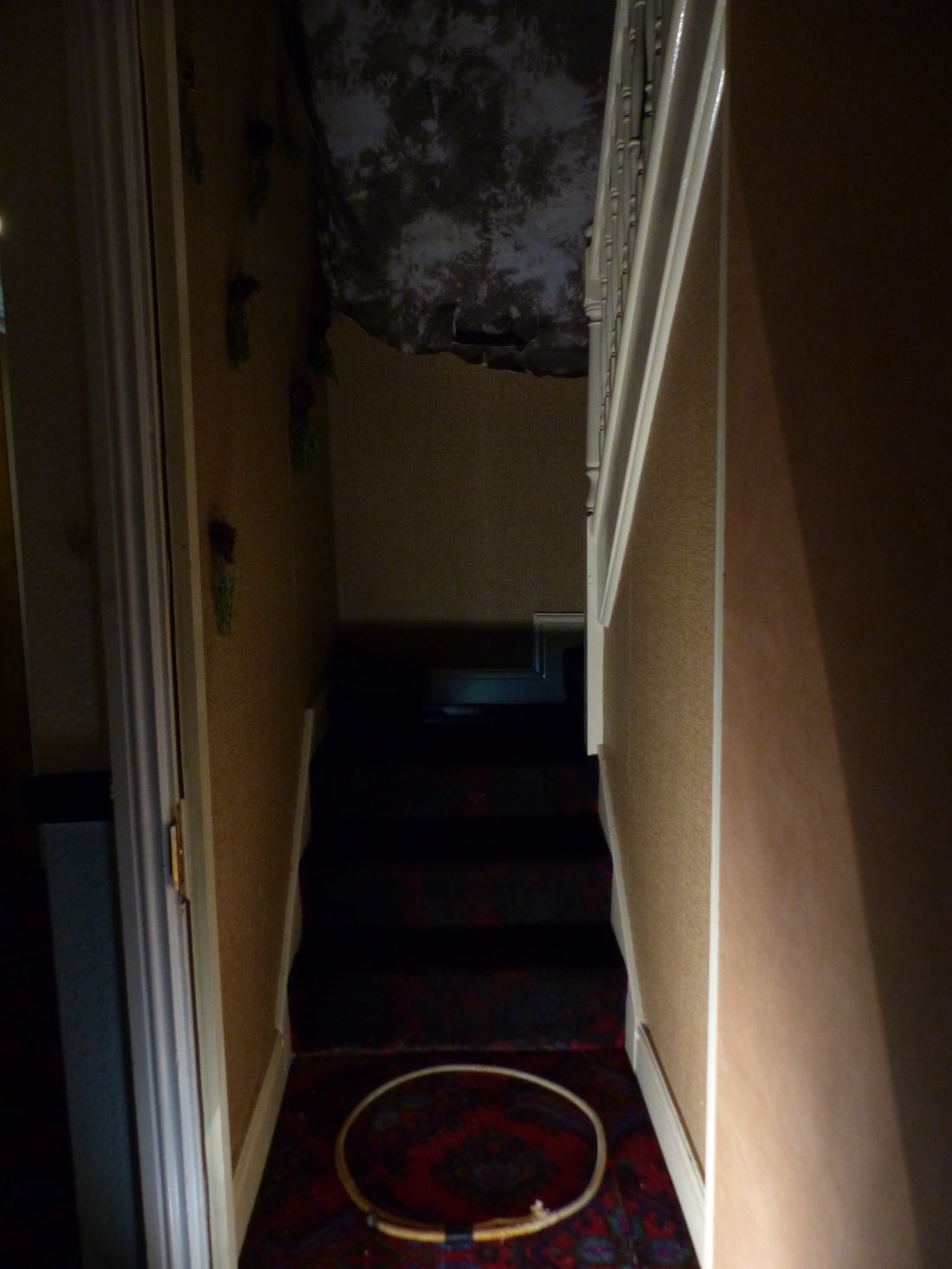
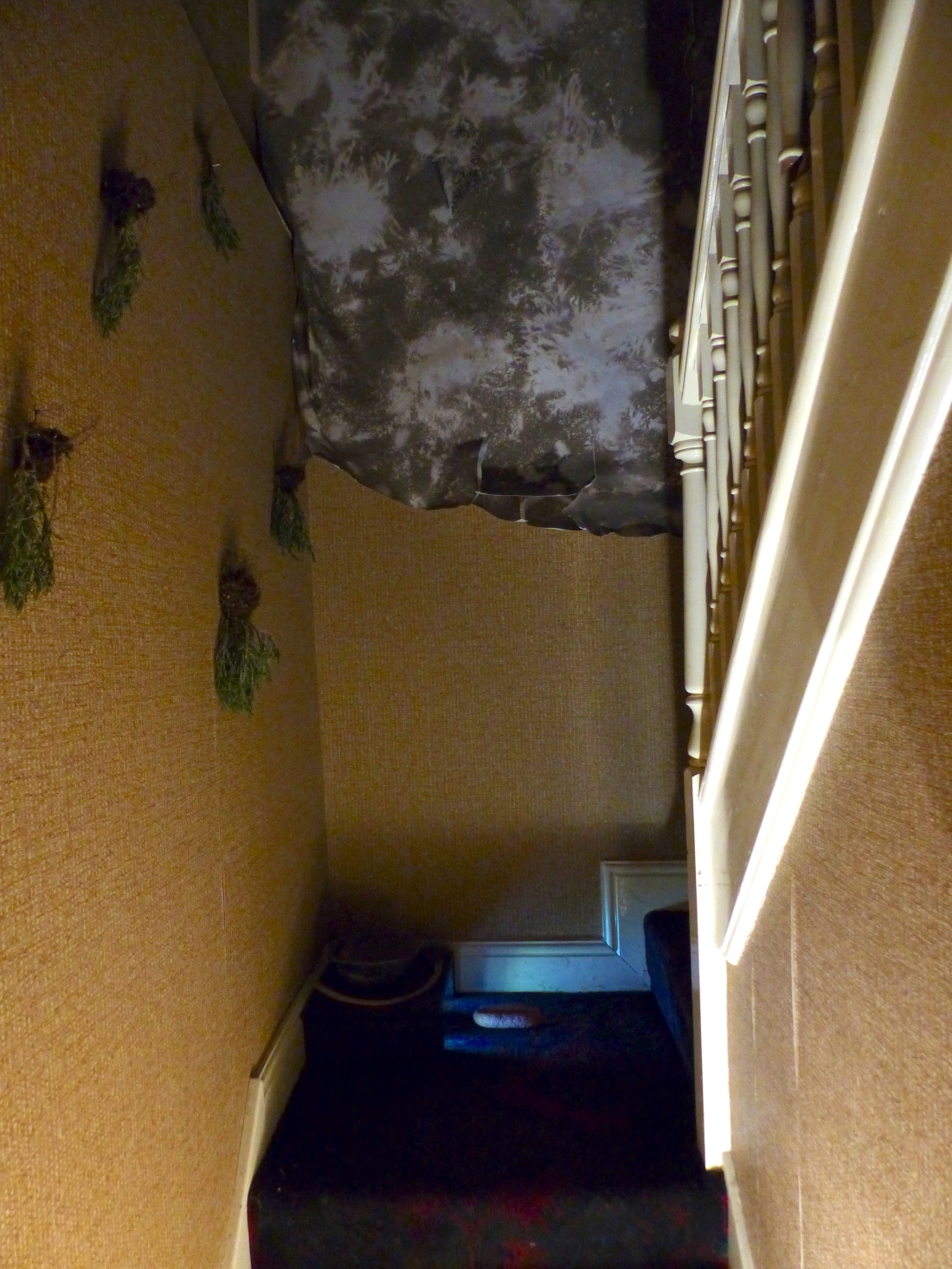
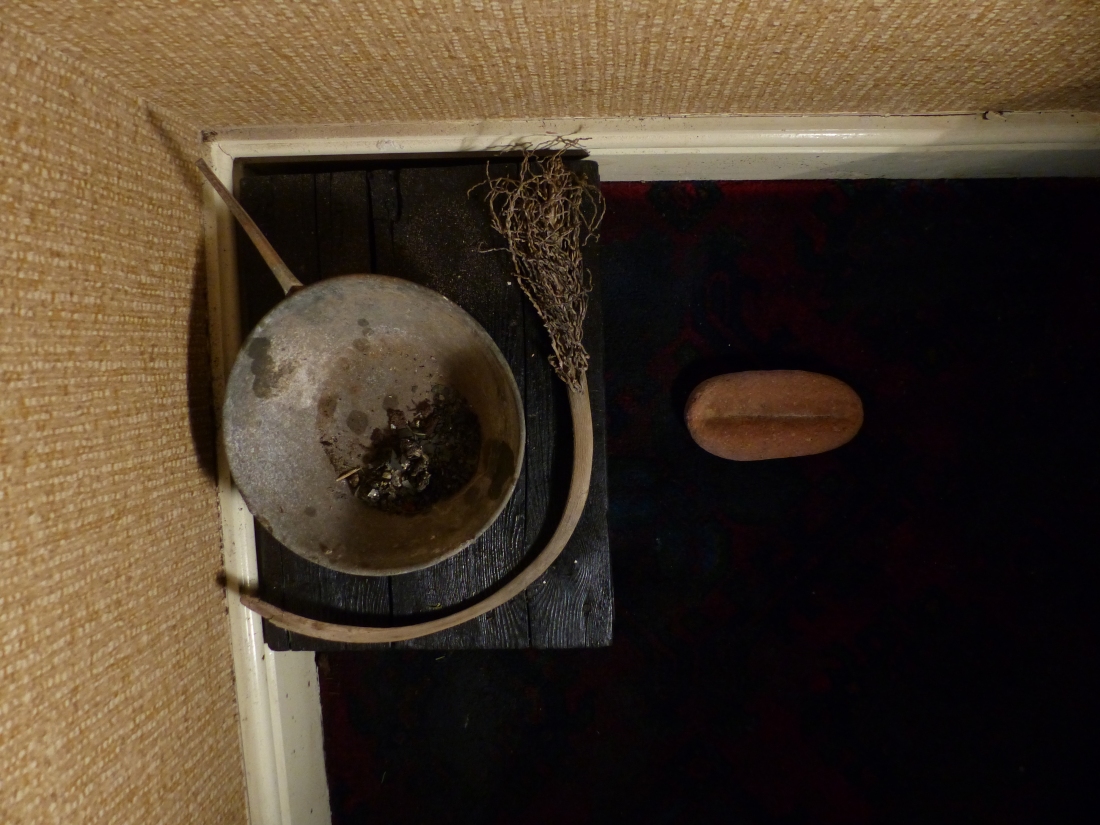
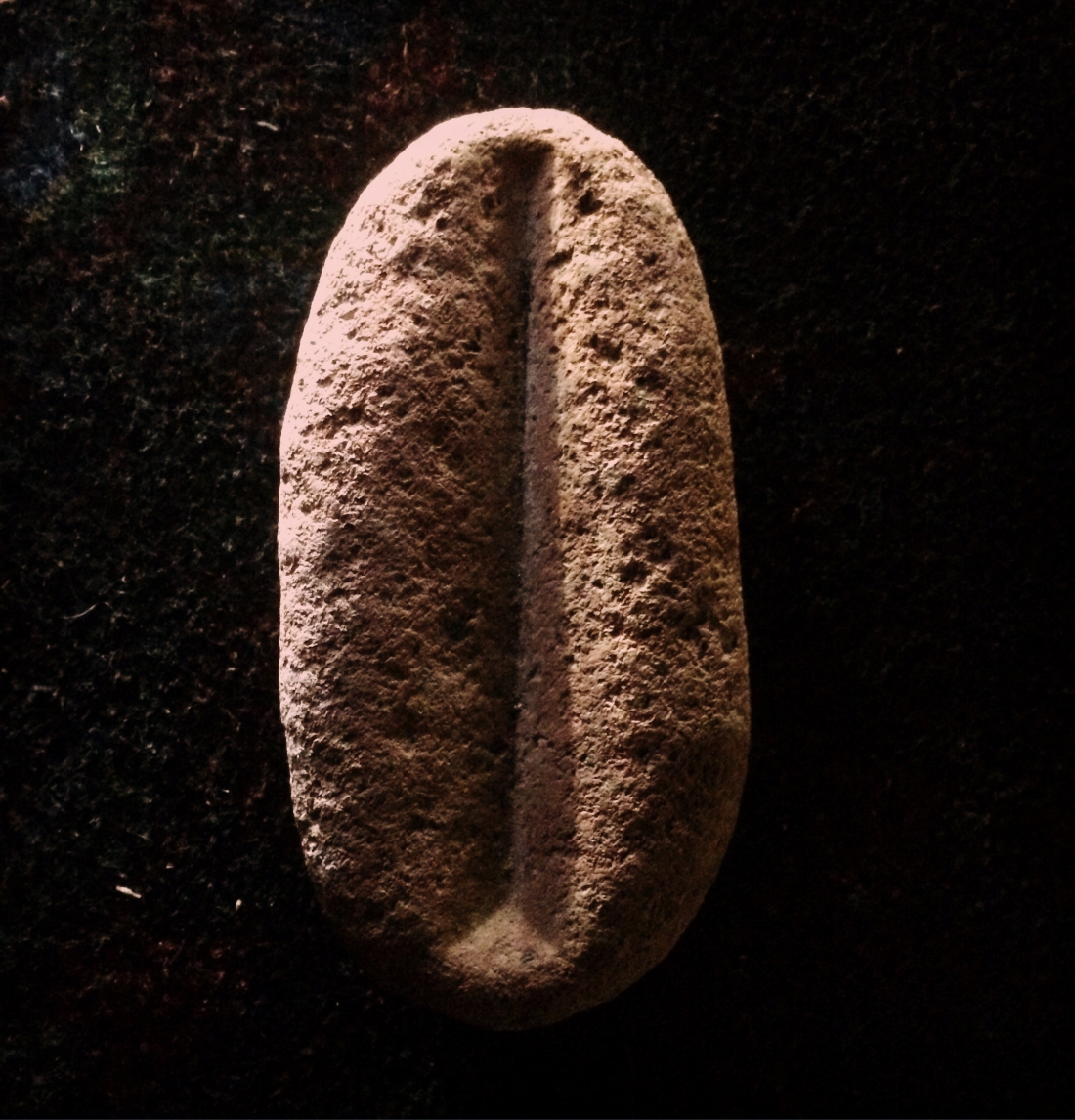
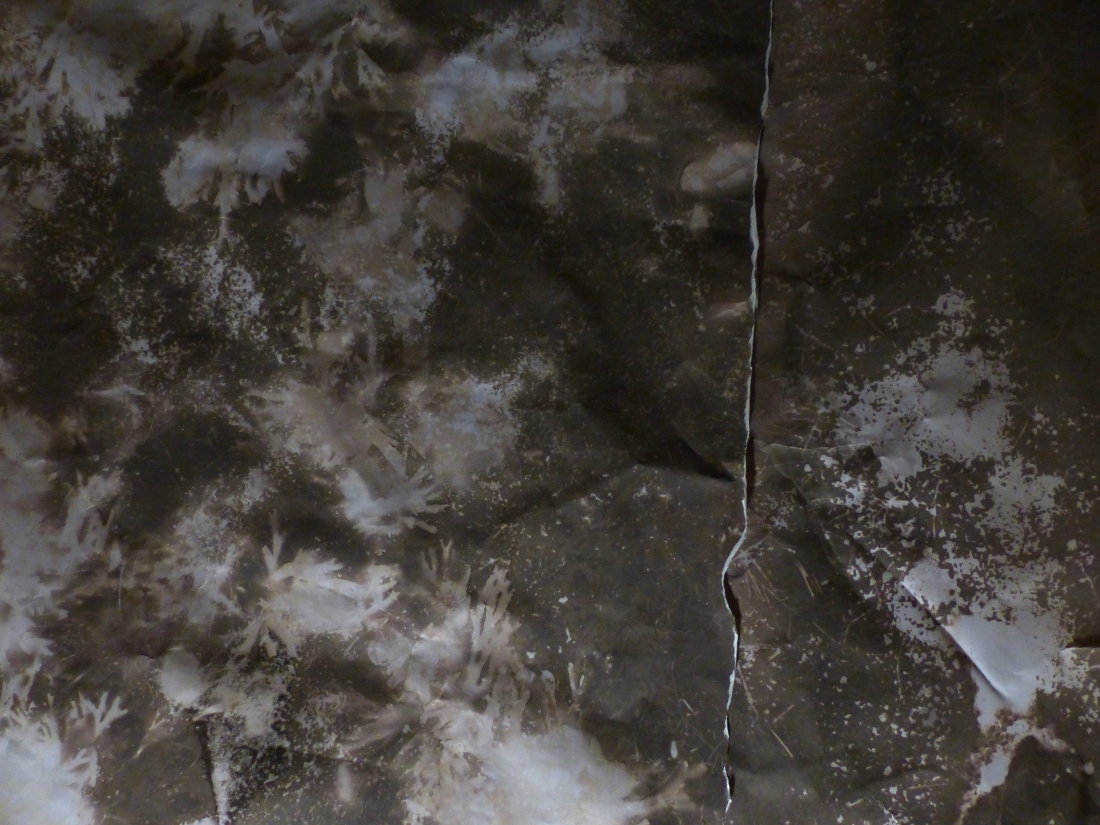
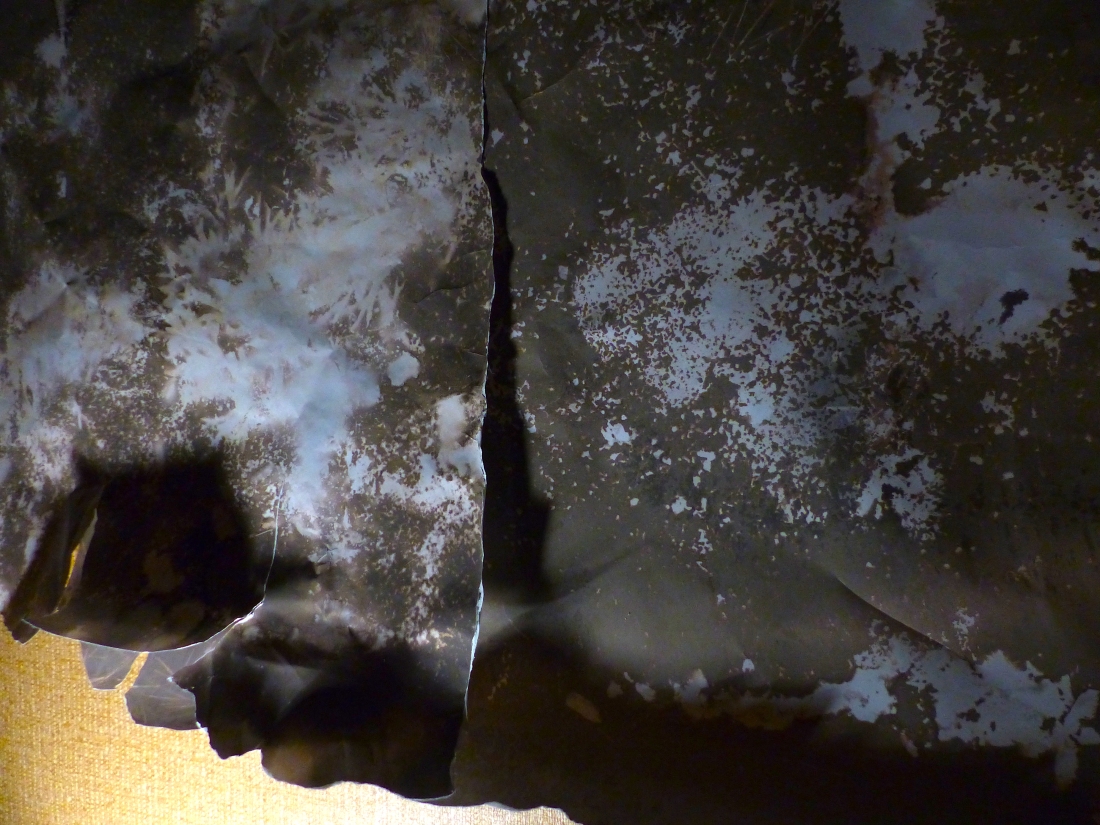
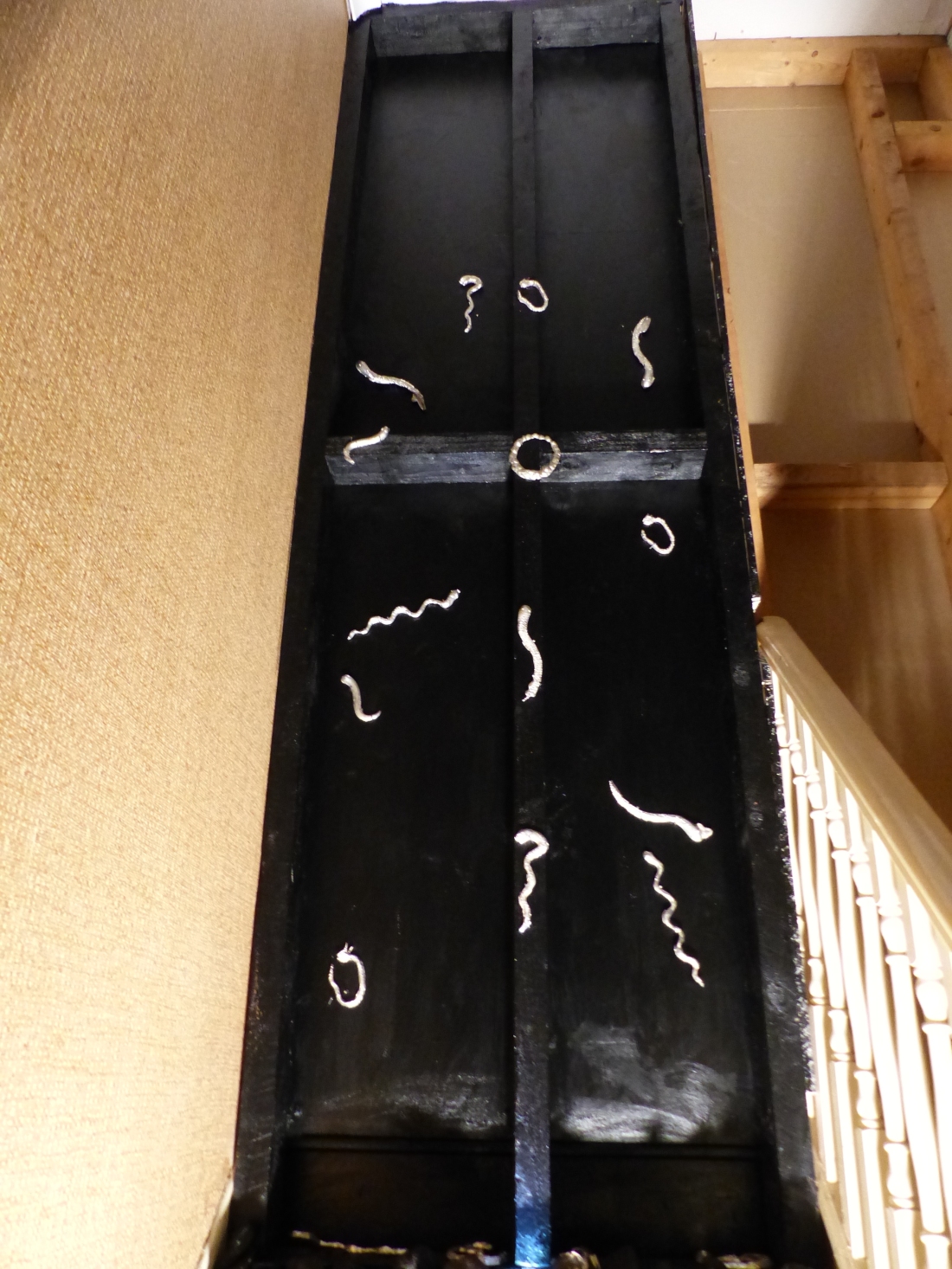
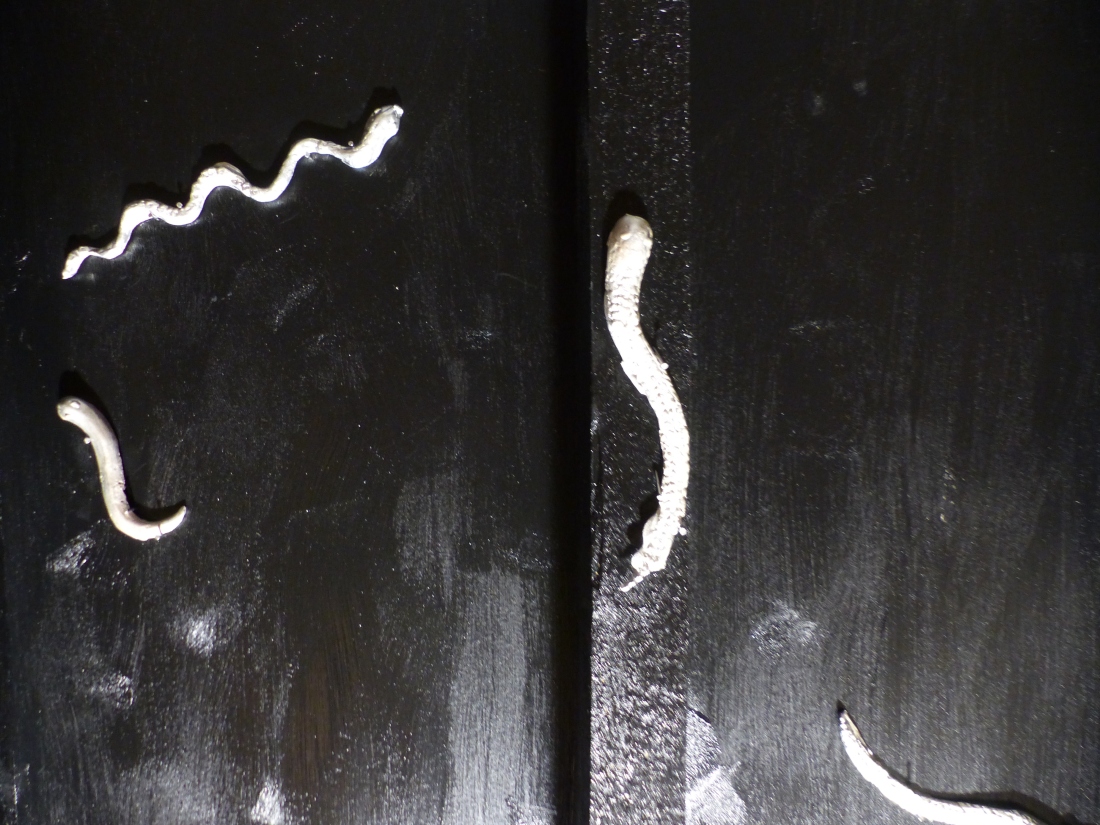
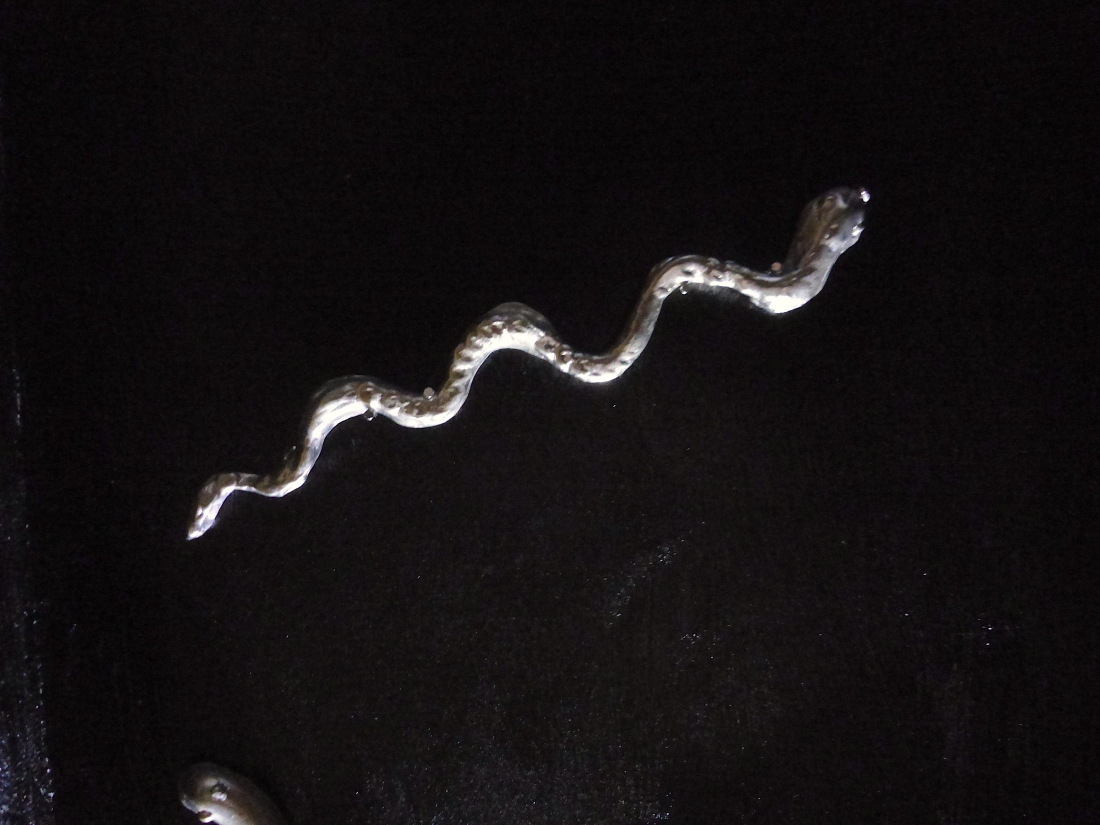
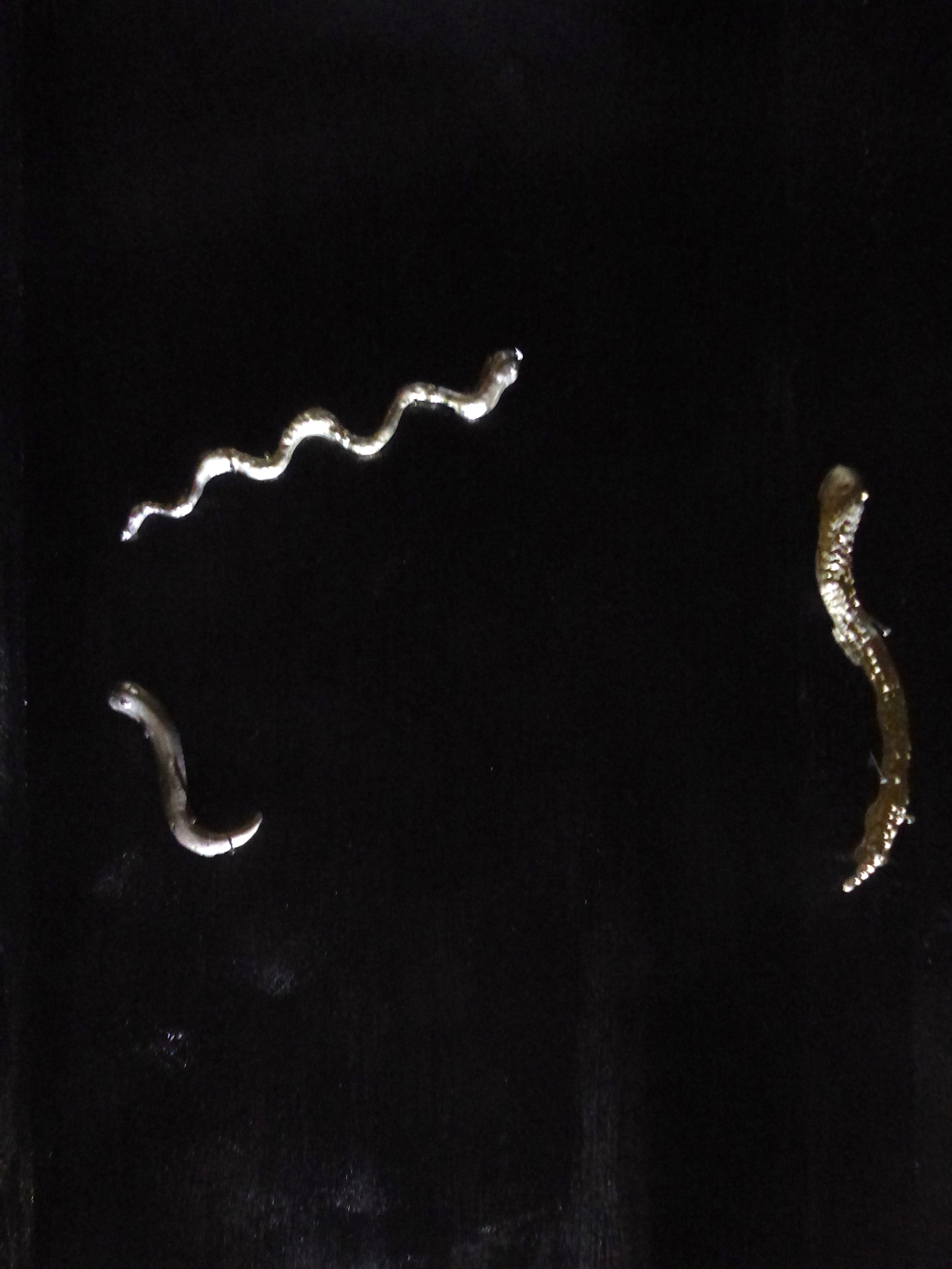
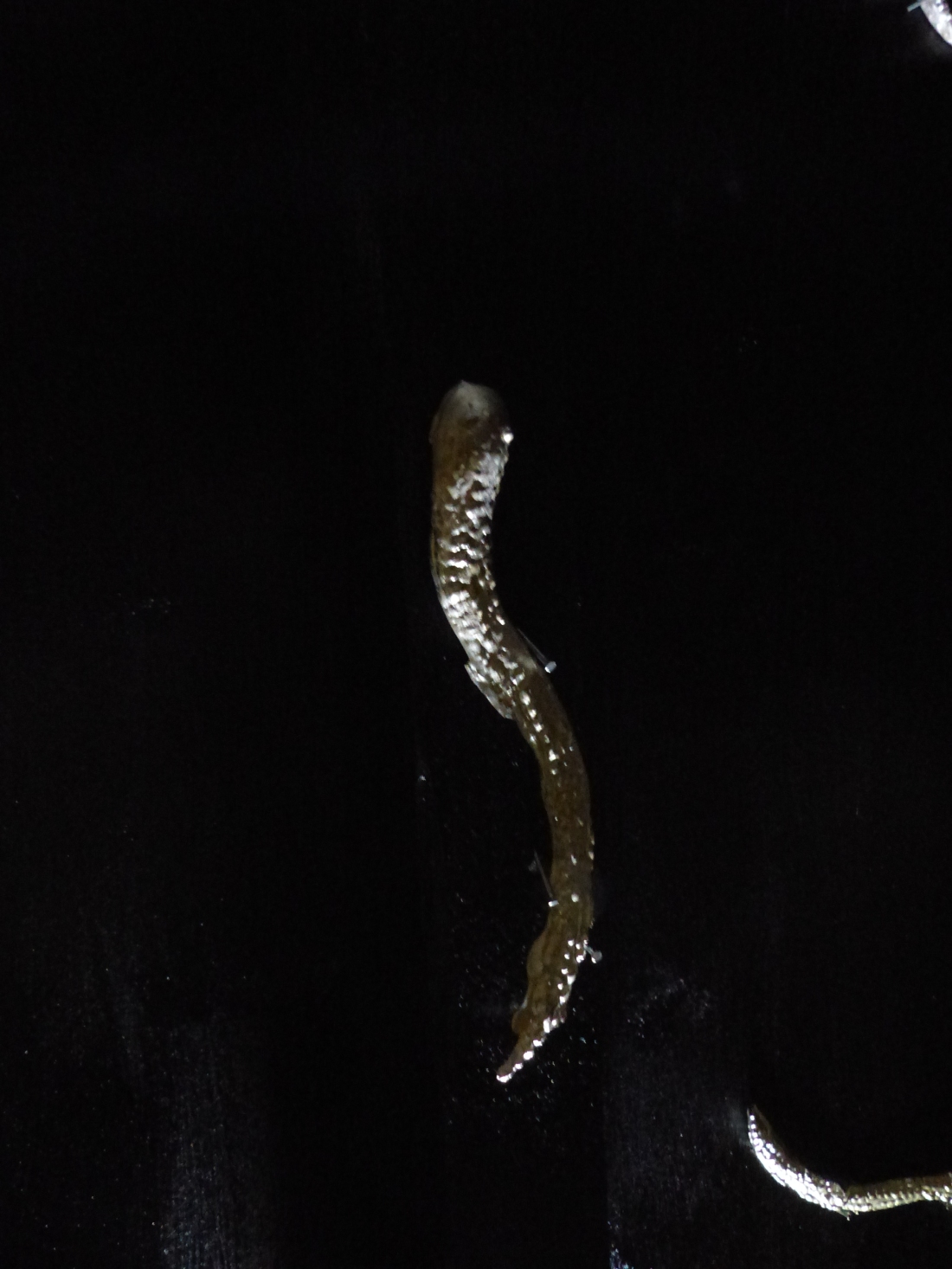
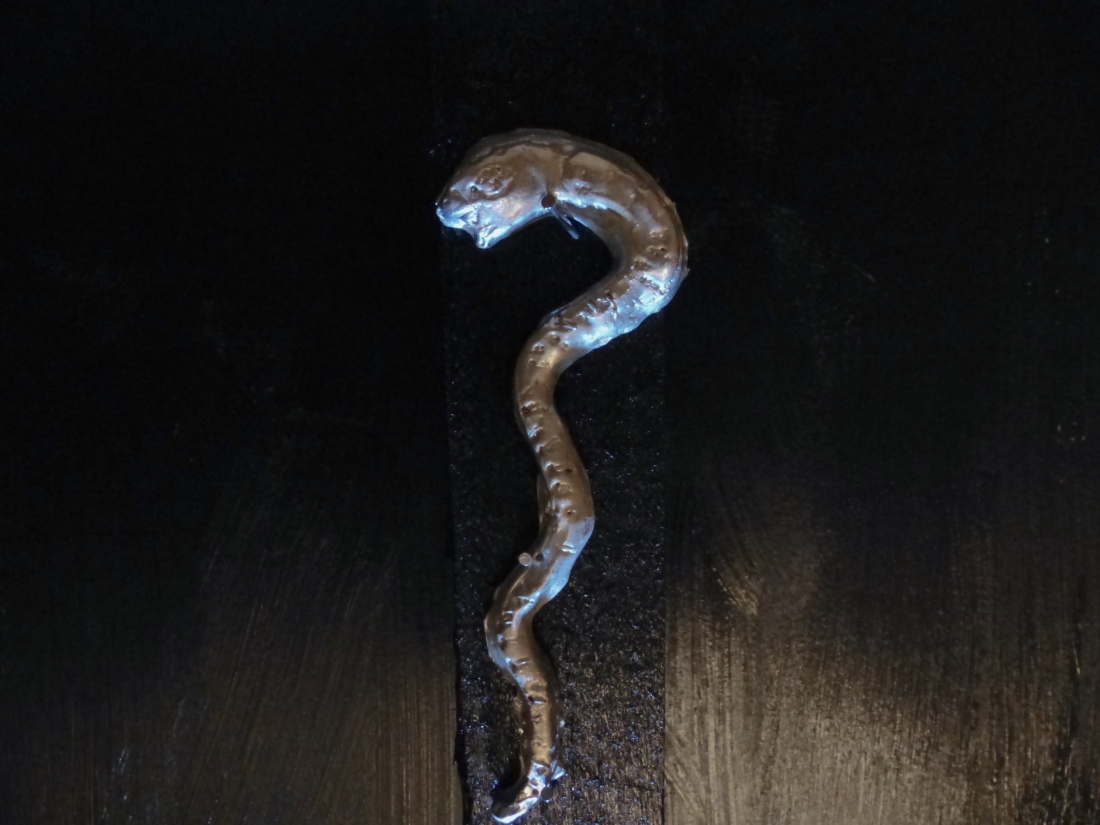
A collaborative installation with Chloe Ashley for “At the Violet Hour”, Nayland Rock Hotel, Margate, 3 February to 11 March 2018, curated by Chiara Williams and Shaun Stamp. This is part of the “Journeys with The Waste Land” programme at Turner Contemporary, February 3- May 7 2018.
Our piece is a reference to Tiresias, the blind prophet and key voice in The Fire Sermon (section III of The Waste Land), whose gender changed on encountering mating snakes. The etymology of Thanet also has a serpentine connection: the 7th-century Archbishop Isidore of Seville recorded an apocryphal folk-etymology in which the island’s name is fancifully connected with the Greek word for death -Thanatos-stating that Thanet, “an island of the ocean separated from Britain by a narrow channel … [was] called Tanatos from the death of serpents; for while it has none of its own, soil taken from it to any place whatsoever kills snakes there.”
The installation comprises of hung rosemary, cast pewter snakes, a fertility stone, and a low table showing the remains of a burning ritual, installed as part of a shrine, together with a lumen print made on the terrace of the Nayland Rock Hotel in the light of the full -super- moon on January 31st 2018. It is in a sealed staircase and is entered by steeping through a threshold circle. On going up the stairs you have the rosemary on your side and confront the lumen print in front of you, with the ritualist remains and fertility stone below. On turning the staircase you see the blackened “altar” of pewter snakes with sea coal placed below.
This installation is deliberately dimly lit and as a consequence hard to represent photographically.
QUEST
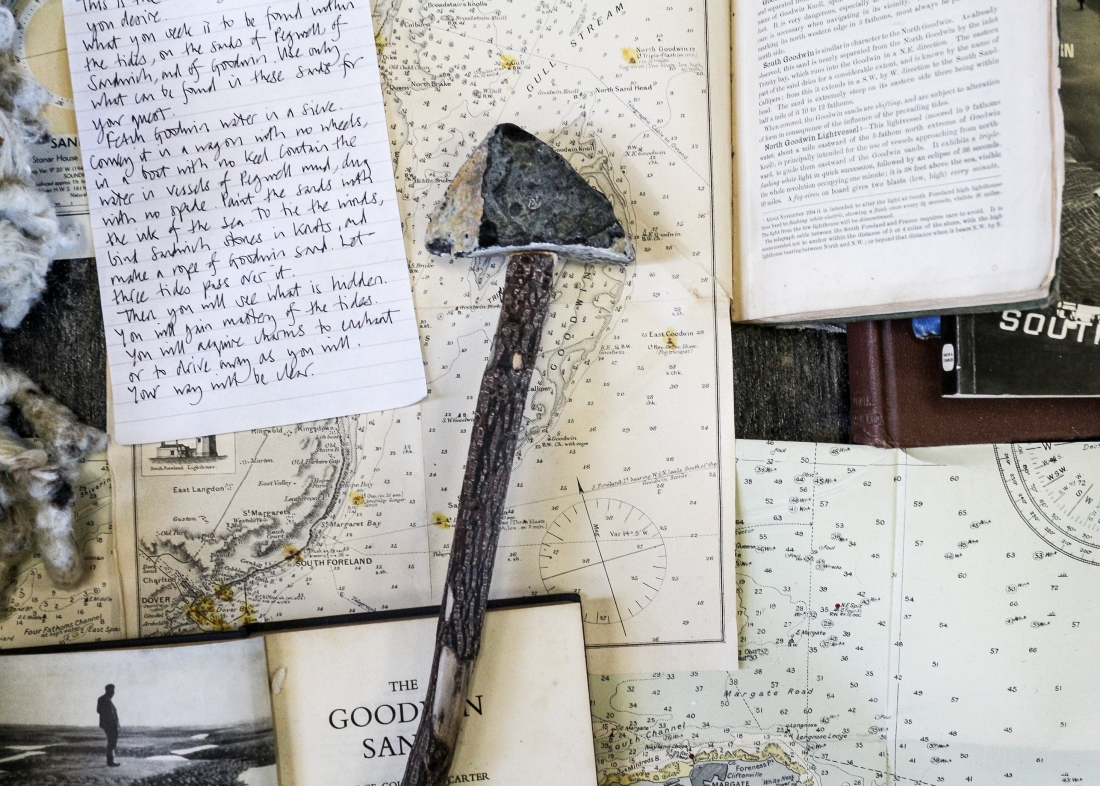
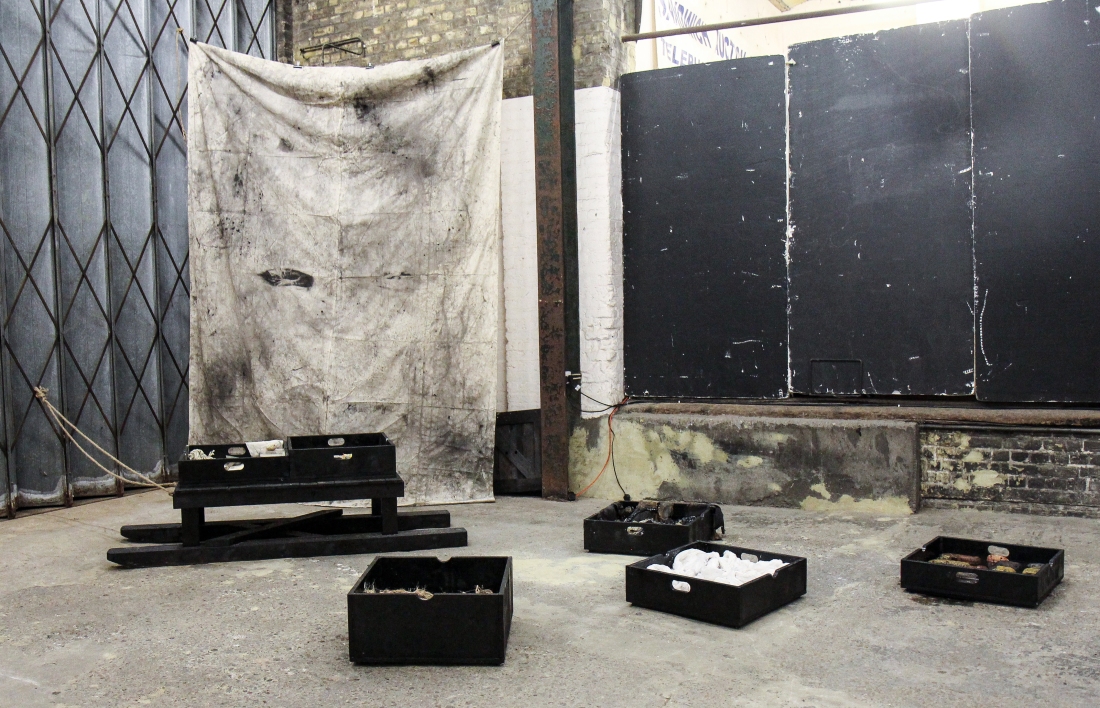
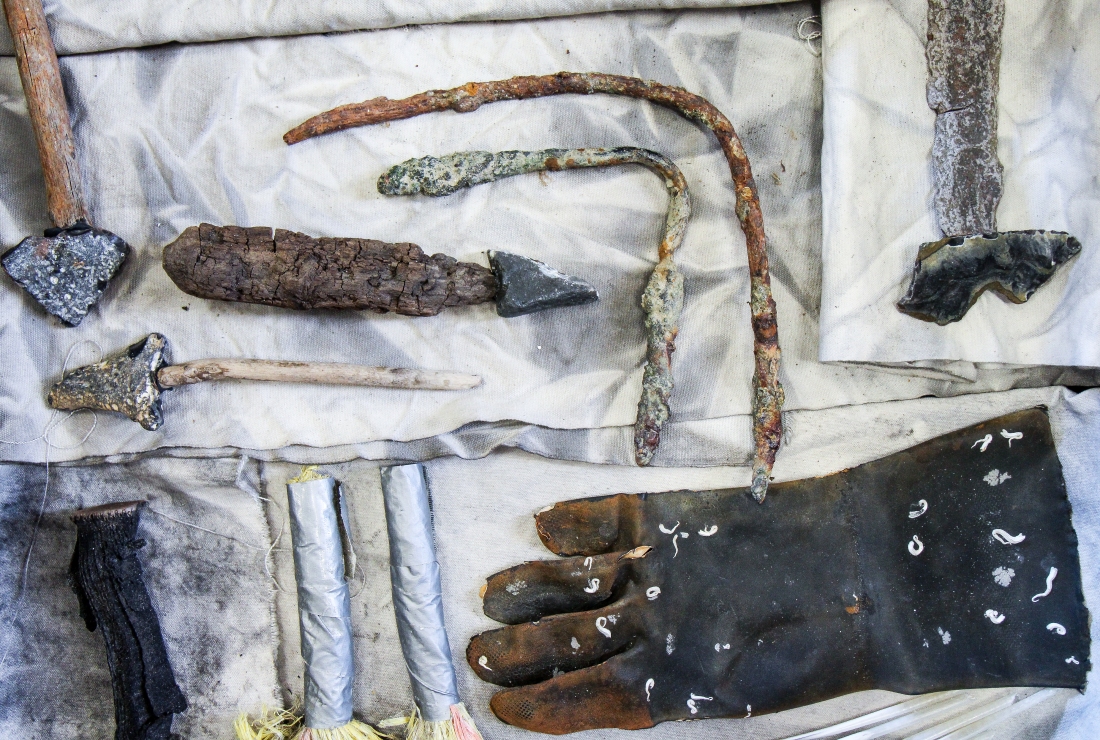
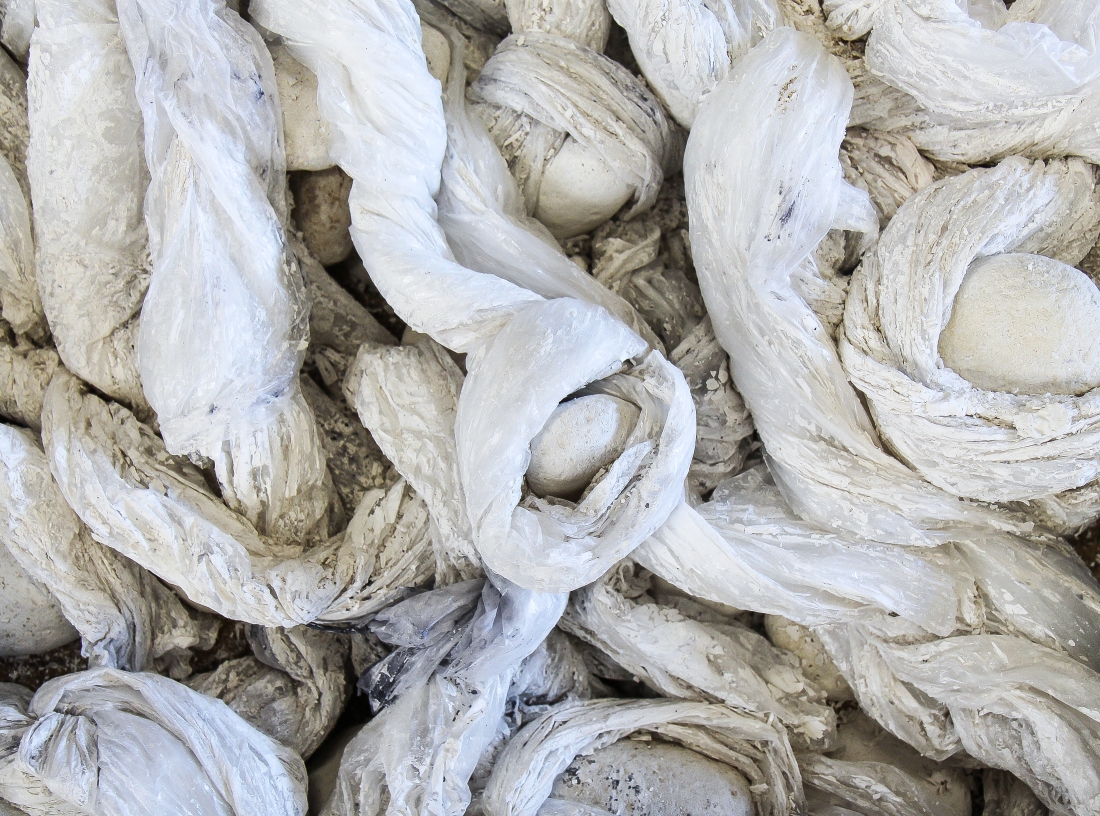
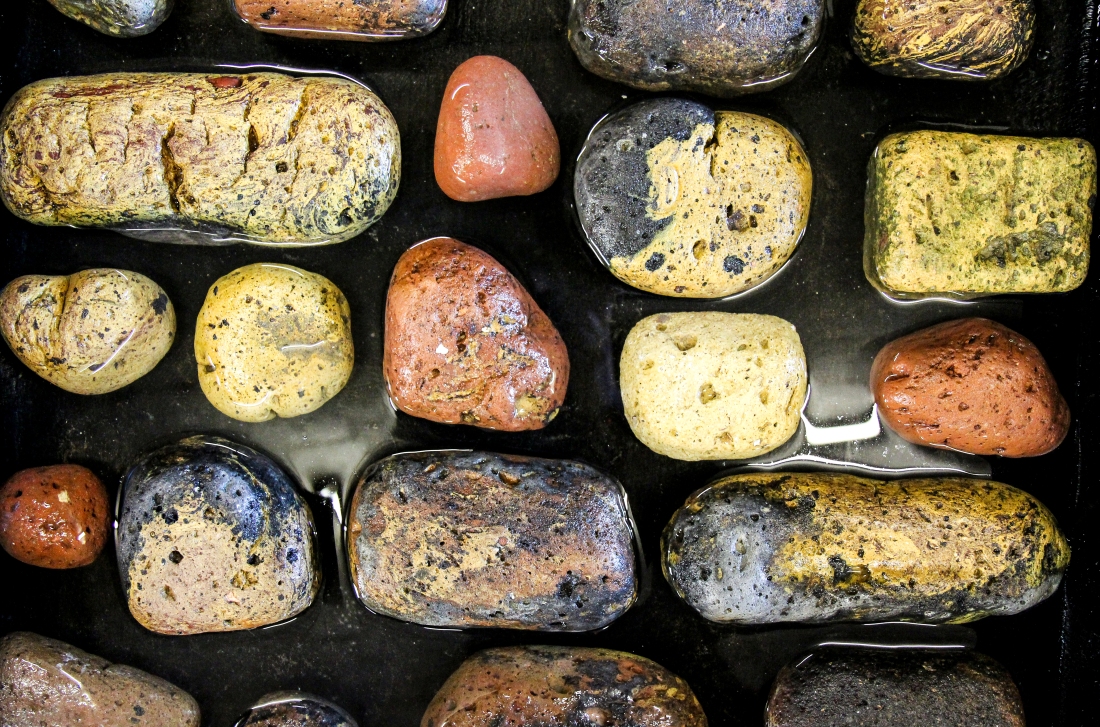
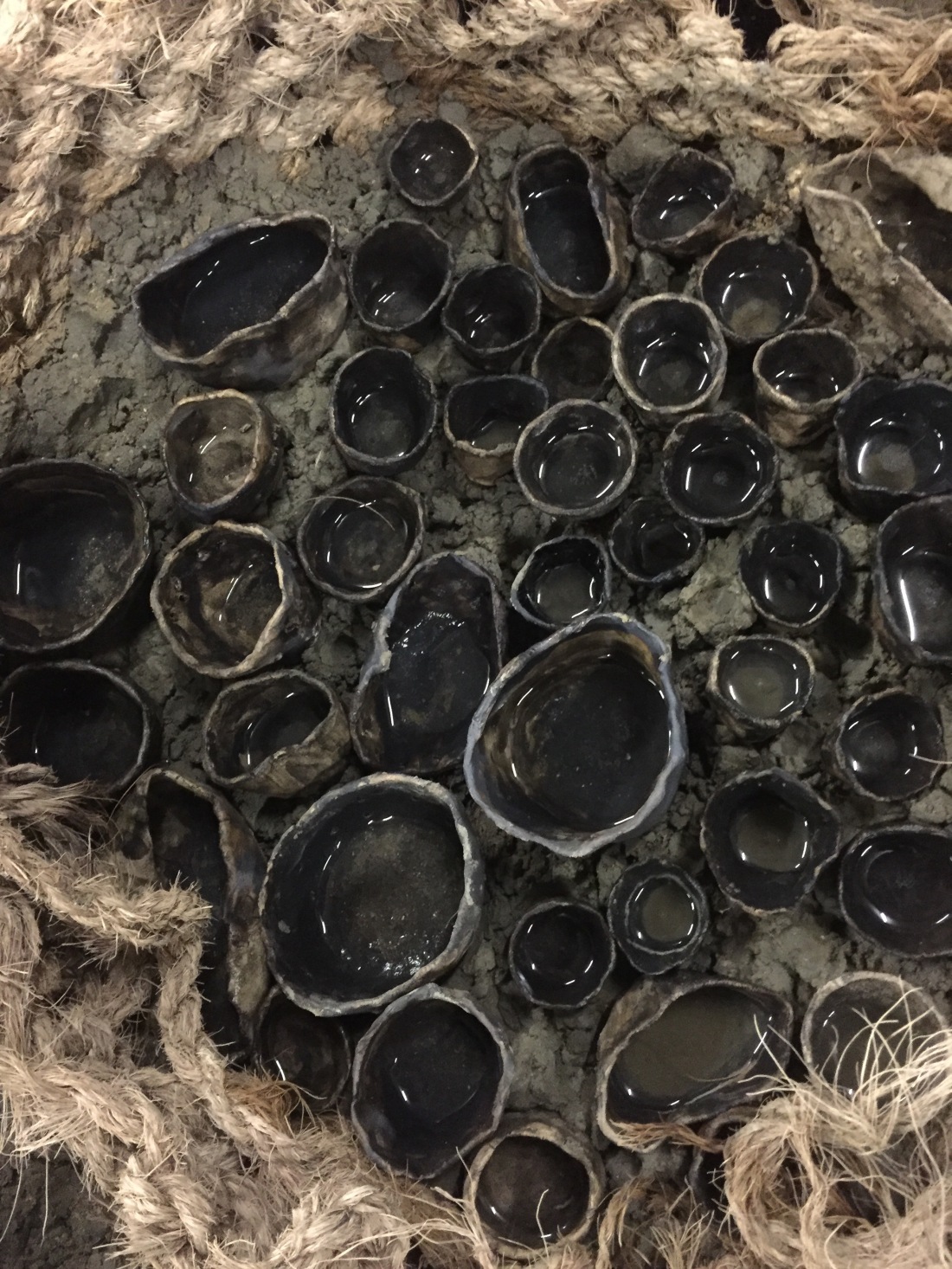
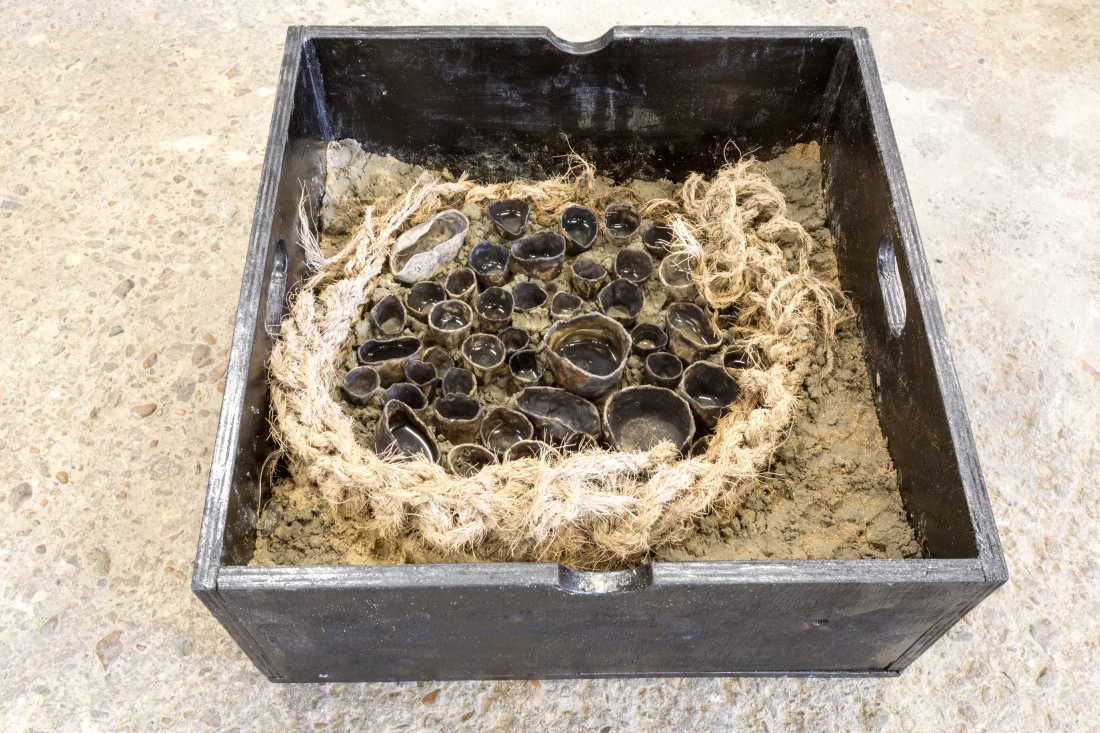
Images show “Quest”, exhibited at The Well, OSE, November 2017. Installation comprising bitumen painted wooden sledge, cuttlefish ink immersed canvas, and bitumen painted boxes containing research material and tools (on sledge), and sculptural pieces made from manipulated foraged coastal materials in varying states of submersion (in boxes on floor).
“Quest” is the culmination of work exploring submerged spaces, and materials caught in the ebb and flood. Inspired by the idea of a quest, I made expeditions to specific Thanet coastal spaces and challenged myself to make particular artefacts informed by finds at these locations. By setting objectives of working only with foraged matter and experiments with submersion I have established a new, marine palette for my materials investigation (including bitumen, cuttlefish ink, rubber, and plastic), and have created a set of narratives surrounding the objects formed, which have connections with the archaeological discoveries and mythologies embedded in the tidal sites visited.
PEGWELL BAY RESEARCH
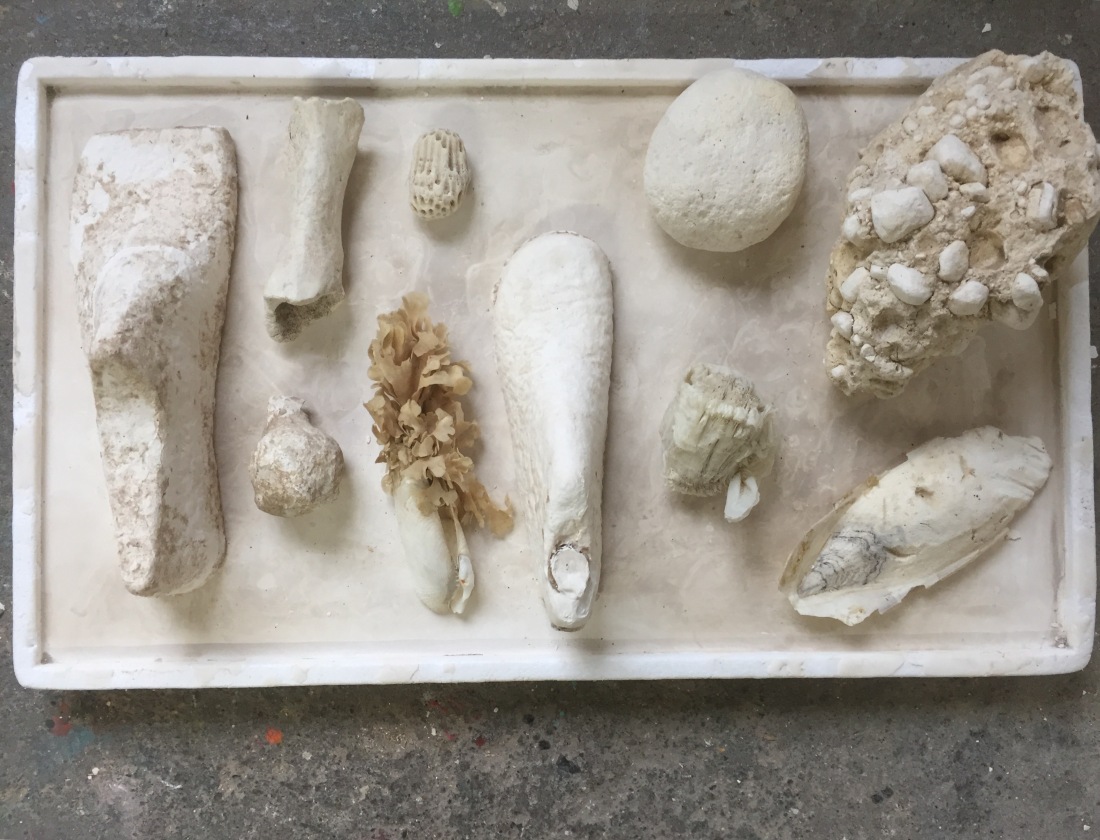
The palette of Pegwell Bay.
Casts of shoe inserts made in plaster to simulate chalk amidst found marine materials: Pegwell Bay was the site of the landing of the Romans, Vikings, and St Augustine (who brought Christianity to Britain).
DANUBE ARCHAEOLOGY
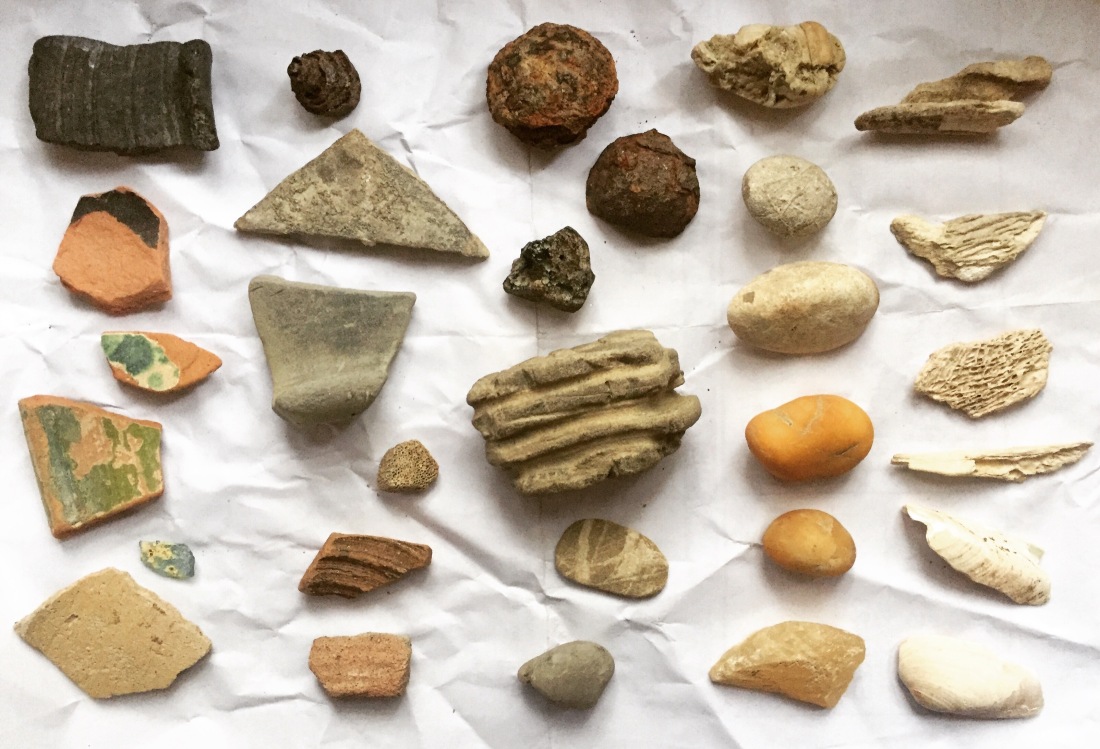
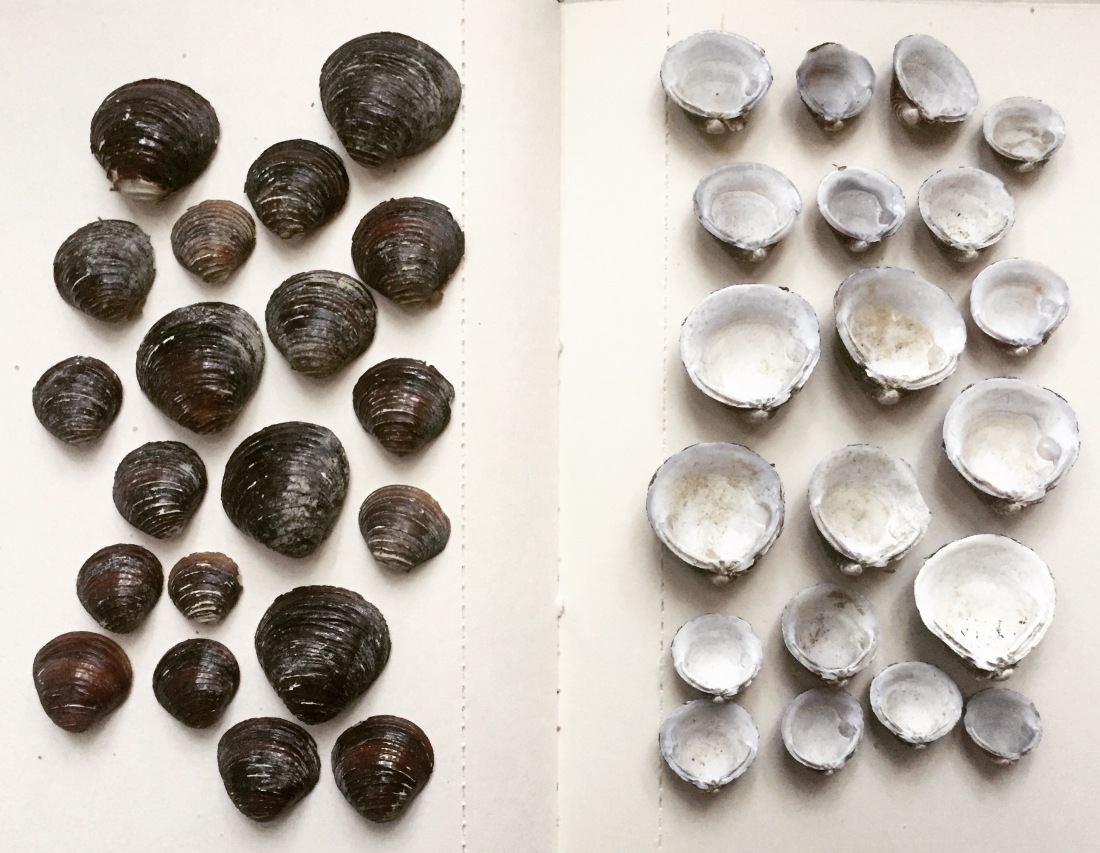
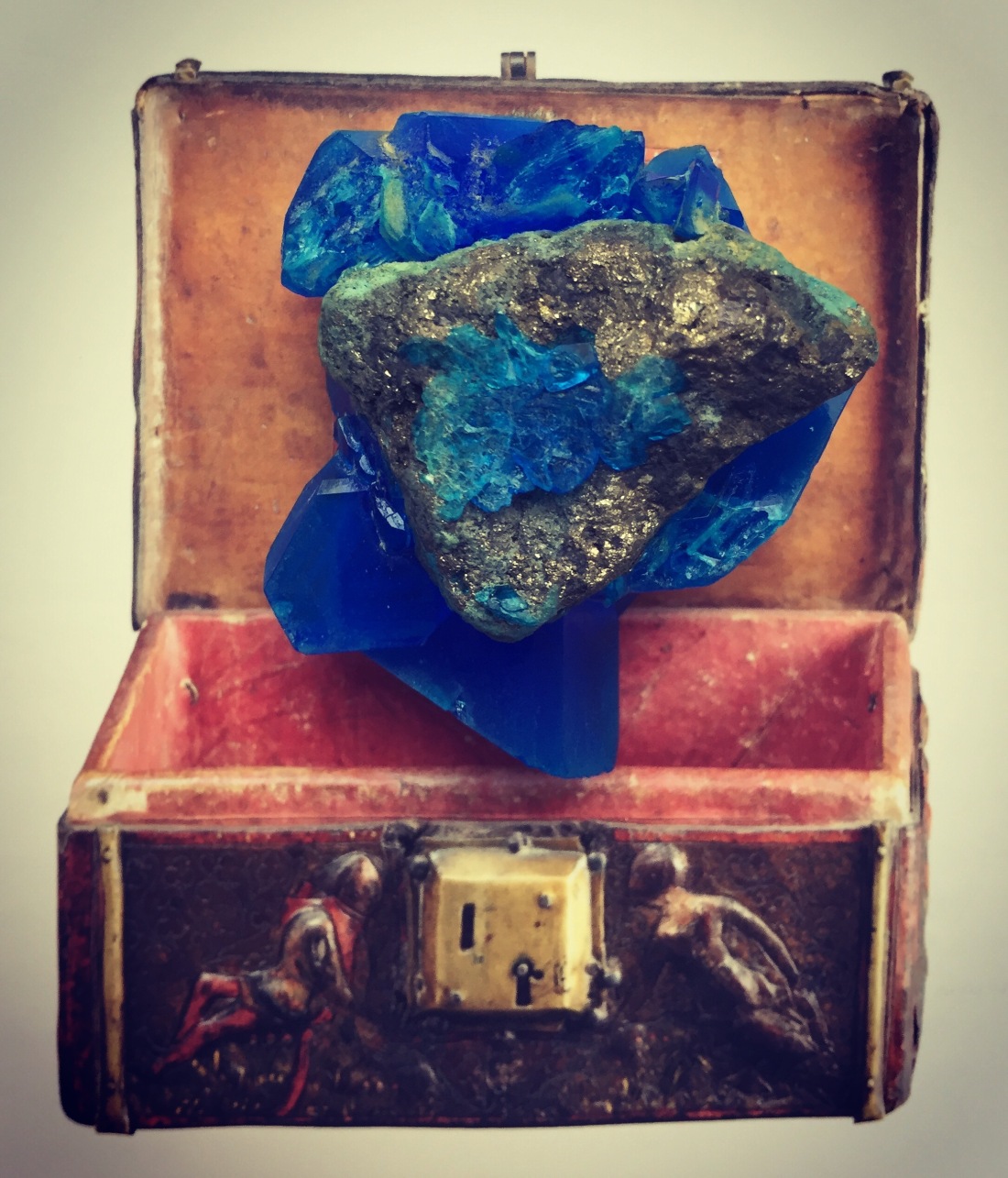
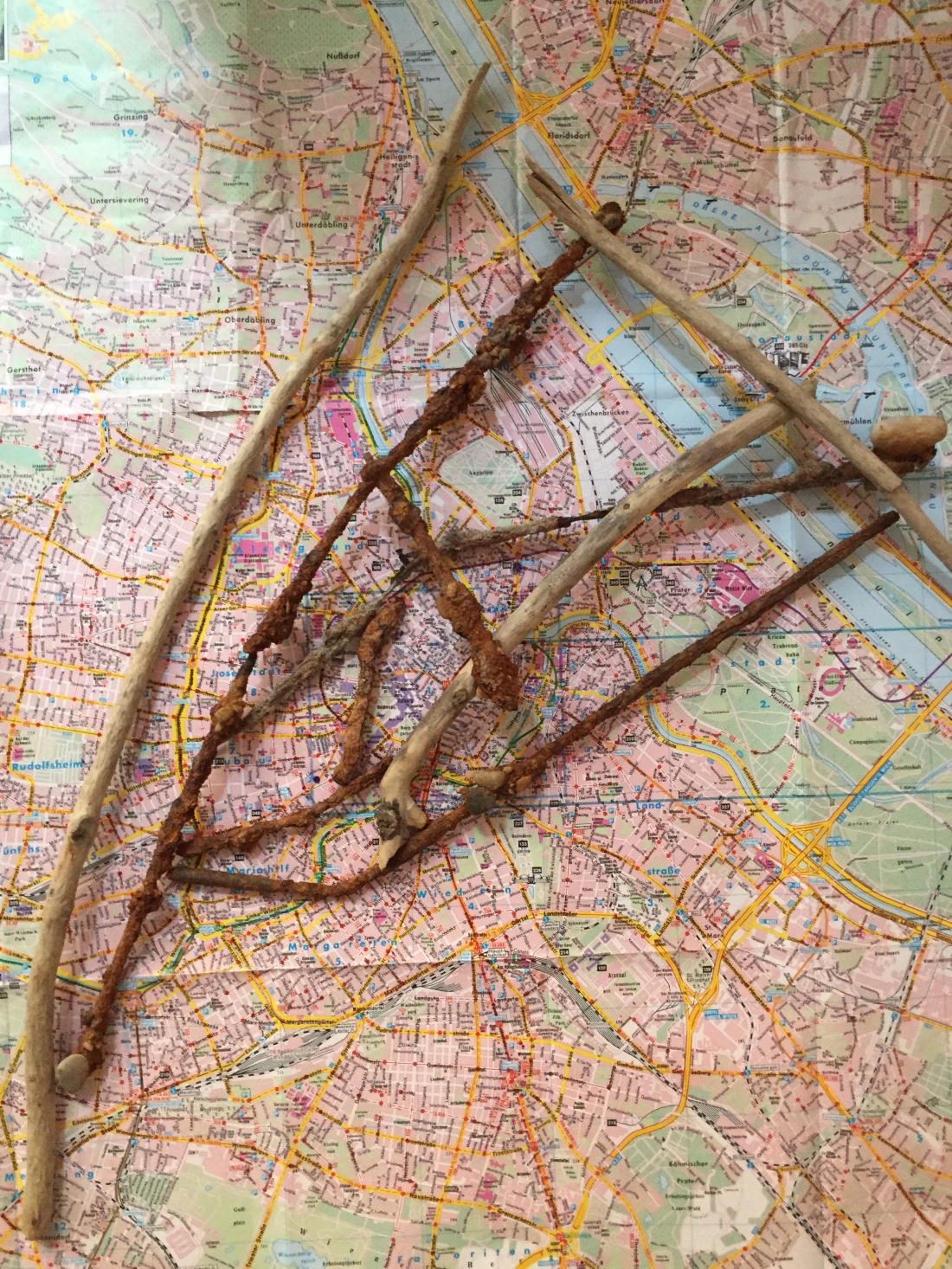
Top two images: between two countries. Fragments and river clams found on the Danube banks at Ezstergom, Hungary and Sturovo, Slovakia
Third image: Azurite (actual) from Hungary on a medieval Slovakian casket (found image)
Bottom image: my route around Vienna marked with sticks found in the Danube
STATEMENT
Sara Trillo: Artist Statement
My current work has been inspired by the idea of a quest: specifically to make an expedition to submerged coastal spaces and challenge myself to make particular artefacts formed by materials caught in the ebb and flood at these locations. As part of this I have been making tools to excavate finds and an oversized sledge to pull these on, and have primarily used Pegwell Bay- site of Roman/Viking/ St Augustine’s landings- as a focus for my research. By setting myself objectives of working with found materials and experiments with submersion I have established a marine palette of bitumen, chalk, cuttlefish ink, rubber, sand and plastic, and have developed narratives inspired by the location, as well as making an expedition in a long tradition of people traversing this historical site.
I have always used specific environments to locate research, drawing on archaeological, geographical and historical references to form objects, paintings and narratives to which I hope to ascribe a form of mythical cultural belief. A desire to collage fragments together to generate a new meaning is always at the core of my practice, whether this be found materials, layers of paint, or snatches of text. Likewise, in working on projects with public participation, I set up an overriding fictional structure in which I act as a puppet master, attempting to bring all the diverse collaborative elements together.
PLASTER MOUNTAINS
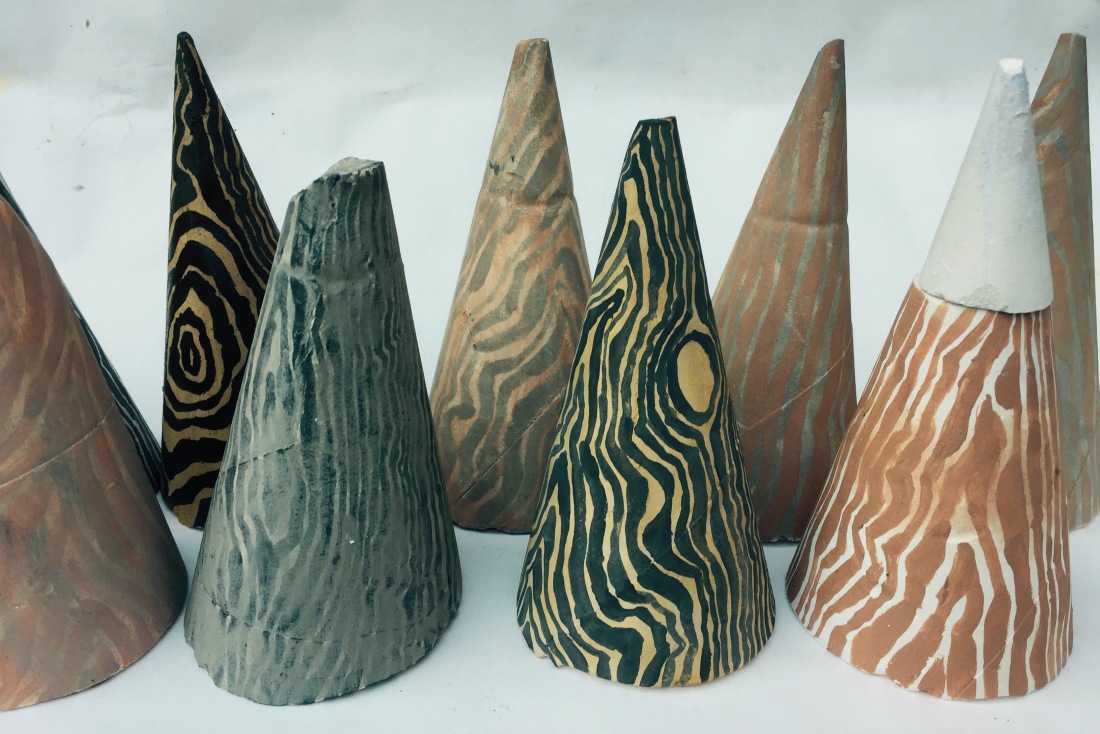
Lines inspired by floorboard contours as below. Painted with different clays/ink/shellac
